EMBRACING AUTONOMY
Retailers must keep up with advancing store technology









FALL BEER AND WINE FLAVORS
Colder weather means richer notes, holiday varieties ON THE EDGE
Shelf solutions highlight products to lift sales


PG’S 2023 EDITORS’ PICKS: MAKE ROOM FOR THE GOOD STUFF
September 2023 Volume 102, Number 9 www.progressivegrocer.com Giant Co. celebrates 100 years of connecting families for a better future UNBREAKABLE BONDS
John Ruane, President, The Giant Co.
Connecting people through food they love.
Drive sales with new items your shoppers will love this fall!

©2023 Campbell Soup Company



Features 14 PROGRESSIVE GROCER’S 2023 EDITORS’ PICKS The Good Stuff Progressive Grocer once more highlights the best new products of the past year. Contents 09.23 Volume 102 Issue 9 10 NIELSEN’S SHELF STOPPERS Departments 11 MINTEL GLOBAL NEW PRODUCTS Salty Snacks 12 ALL’S WELLNESS Kicking Bad Food Habits 74 AHEAD OF WHAT’S NEXT A Dream Come True 6 EDITOR’S NOTE Still Happy Places 8 IN-STORE EVENTS CALENDAR November 2023 COVER STORY Unbreakable Bonds The Giant Co. celebrates 100 years of connecting families for a better future. 36 PROGRESSIVE GROCER September 2023 3 26 NONFOODS Instant Gratification An Instant Power executive explains what makes his company’s plumbing and cleaning products stand apart from those of competitors.
44 GUEST VIEWPOINT
Laying the Operational Foundation for Autonomous Stores
Retailers must keep pace with advancing technology — and the competition.

48 FRESH FOODS
Prepared to the Max How retailers can take their prepared food and foodservice operations to the next level.

51 SOLUTIONS
Kitted Out for Baking Success
Kits can enable consumers to add a bit of professional pizzazz to home-baked or store-bought cakes, or help families create their own branded baked goods.

54 FROZEN FOODS
Cooler Than Ever
Frozen dessert offerings play up healthy attributes, convenience and innovative flavors while still offering high quality and indulgence.
56 BEVERAGES
Turning Points
The arrival of cold weather brings richer notes and the return of holiday beer and wine favorites.
60 GUEST VIEWPOINT
Food Safety is Good for Business

An expert offers three steps for grocers to realign their food safety programs.
64 TECHNOLOGY
Leading Edge
New technologies in this area enable grocers to better connect with customers in an increasingly omnichannel world.

8550 W. Bryn Mawr Ave. Ste. 200, Chicago, IL 60631 Phone: 773-992-4450 Fax: 773-992-4455
www.ensembleiq.com
BRAND MANAGEMENT
VICE PRESIDENT & GROUP BRAND DIRECTOR Paula Lashinsky 917-446-4117 plashinsky@ensembleiq.com
EDITORIAL EDITOR-IN-CHIEF Gina Acosta gacosta@ensembleiq.com
MANAGING EDITOR Bridget Goldschmidt bgoldschmidt@ensembleiq.com
SENIOR DIGITAL & TECHNOLOGY EDITOR Marian Zboraj mzboraj@ensembleiq.com
SENIOR EDITOR Lynn Petrak lpetrak@ensembleiq.com
MULTIMEDIA EDITOR Emily Crowe ecrowe@ensembleiq.com
CONTRIBUTING EDITORS
Chris Boyles, Michael Gabay, Mike Duff, Jenny McTaggart and Barbara Sax
ADVERTISING SALES & BUSINESS
ASSOCIATE PUBLISHER, REGIONAL SALES MANAGER (INTERNATIONAL, SOUTHWEST, MI)
Tammy Rokowski 248-514-9500 trokowski@ensembleiq.com
REGIONAL SALE MANGER Theresa Kossack (MIDWEST, GA, FL) 214-226-6468 tkossack@ensembleiq.com
REGIONAL SALES MANAGER (EAST COAST)







Dave Cappelli 312-505-3385 dcappelli@ensembleiq.com
ACCOUNT EXECUTIVE/CLASSIFIED ADVERTISING Terry Kanganis 201-855-7615 • Fax: 201-855-7373 tkanganis@ensembleiq.com
CLASSIFIED PRODUCTION MANAGER Mary Beth Medley 856-809-0050 marybeth@marybethmedley.com
PROJECT MANAGEMENT/PRODUCTION/ART
ART DIRECTOR Bill Antkowiak bantkowiak@ensembleiq.com
ADVERTISING/PRODUCTION MANAGER Jackie Batson 224-632-8183 jbatson@ensembleiq.com
MARKETING MANAGER Rebecca Welsby rwelsby@ensembleiq.com
SUBSCRIPTION SERVICES
LIST RENTAL mbriganti@anteriad.com
SUBSCRIPTION QUESTIONS contact@progressivegrocer.com
CORPORATE OFFICERS
CHIEF EXECUTIVE OFFICER Jennifer Litterick
CHIEF FINANCIAL OFFICER Jane Volland
CHIEF OPERATING OFFICER Derek Estey
CHIEF PEOPLE OFFICER Ann Jadown
CHIEF STRATEGY OFFICER Joe Territo
PROGRESSIVE GROCER (ISSN 0033-0787, USPS 920-600) is published monthly by EnsembleIQ, 8550 W. Bryn Mawr Ave. Ste. 200, Chicago, IL 60631. Single copy price $14, except selected special issues. Foreign single copy price $16, except selected special issues. Subscription: $125 a year; $230 for a two year supscription; Canada/Mexico $150 for a one year supscription; $270 for a two year supscription (Canada Post Publications Mail Agreement No. 40031729. Foreign $170 a one year supscrption; $325 for a two year supscription (call for air mail rates). Digital Subscription: $87 one year supscription; $161 two year supscription. Periodicals postage paid at Chicago, IL 60631 and additional mailing offices. Printed in USA.
POSTMASTER: Send all address changes to brand, 8550 W. Bryn Mawr Ave. Ste. 200, Chicago, IL 60631. Copyright ©2023 EnsembleIQ All rights reserved, including the rights to reproduce in whole or in part. All letters to the editors of this magazine will be treated as having been submitted for publication. The magazine reserves the right to edit and abridge them. The publication is available in microform from University Microfilms International, 300 North Zeeb Road, Ann Arbor, MI 48106. The contents of this publication may not be reproduced in whole or in part without the consent of the publisher. The publisher is not responsible for product claims and representations.
4 progressivegrocer.com
44 Contents 09.23 Volume 102 Issue 9
51 71 EQUIPMENT &
Center Stage Current display solutions can help increase sales for grocers by highlighting products in a unique way. 48 64
DESIGN

GOYA® Coconut Products offer the distinct flavor coconut lovers are looking for in their desserts and drinks. Silky and creamy, they add the tropical touch only the leading Latin brand can deliver. NewLook, Same Great Taste Learn More! Contact your GOYA representative or email salesinfo@goya.com | trade.goya.com ©2023 Goya Foods, Inc.
By Gina Acosta
Still Happy Places
A DEFENSE OF SECURITY MEASURES AT GROCERY STORES.



few months ago, I was fortunate enough to attend the Retail Industry Leaders Association Asset Protection Conference, in Denver. The event featured a plethora of retailers, including many grocers, speaking about the security and theft challenges they’re facing in their physical locations (and online). But they weren’t just talking about the challenges. They brought video, lots of video. Of angry shoppers throwing large items like small appliances at cashiers in an attempt to hurt them. Of shoppers pointing guns at employees while exiting the store, taking a cartful of merchandise without paying for it. Of people getting into shootouts and fistfights in parking lots. Of a man holding a large axe – yes, an axe – that he grabbed from the garden department and holding it near the head of a store manager.

If you work in retail or talk to retailers, then you know that this industry is facing unprecedented challenges when it comes to violence and theft. That’s why I was stunned to read Stacy Torres’ August opinion column in The Los Angeles Times headlined: “Grocery stores used to be my happy place. Then they started locking up the detergent.”
Torres writes that grocery stores “used to be happy places,” but measures such as “locked glass cabinets … erode customers’ spirits and our social fabric, even though it’s unclear whether shoplifting has become the national crisis that some retailers claim.”
Truly a National Crisis
It’s crystal clear, however, that violence and theft in retail stores have become a national crisis. I invite Torres to read Progressive Grocer’s July 2023 special report on asset protection, written by Multimedia Editor Emily Crowe. According to the National Retail Federation’s (NRF) 2022 National Retail Security Survey, overall retail shrink, when taken as a percentage of total retail sales in 2021, accounted for $94.5 billion in losses, up from $90.8 billion in 2020. According to the survey, external theft, excluding organized retail crime (ORC), has become a greater priority for 74.1% of executives, and ORC specifically has become a greater priority for 70.7% of executives. The survey asked participants how much ORC incidents had increased at their organizations between 2021 and 2022. On average, retailers reported that ORC incidents had increased 26.5% between 2021 and 2022.
The NRF survey also showed that eight out of 10 retailers reported increased incidents of violence and aggression this past year. Specifically, customer-on-employee violence has become a greater priority for 77.6% of participating executives, according to the survey.
At the RILA conference, Jacob Gillette, regional asset protection manager for the eastern region at Meijer, told the audience that there has been a 400% increase in “reported customer threats” since 2018, with a sharp jump between 2021 and 2022. The threats aren’t just a problem for retail staff, they’re also a problem for shoppers. An internal Meijer survey showed that customers are extremely anxious and worried about their safety in stores (specifically at the checkout and in parking lots); in response, retailers are rolling out more diverse security measures.
There are myriad reasons that violence and theft are increasing at retail, and there are myriad reasons that these are difficult problems to solve. I recommend that Torres read all of the work that FMI – The Food Industry Association, RILA, NRF and other trade groups, along with the law enforcement, social justice and other communities, are doing to help retailers solve these problems with the urgency and compassion that they deserve.
Accusing retailers of fabricating a crisis to make shopping less of a pleasure is absurd. The last thing retailers want to do is add friction to the path to purchase. Torres says that she enjoys the experience at grocers such Trader Joe’s, Smart & Final, and Nob Hill Foods. As a grocery store fan, she should support the endless efforts of retailers to keep their customer experiences enjoyable – and safe.
Gina Acosta Editor-In-Chief gacosta@ensembleiq.com

6 progressivegrocer.com EDITOR’S NOTE
Scan the QR Code for more information on the GroceryTech event and the Grocery Trends Study.
If you work in retail or talk to retailers, then you know that this industry is facing unprecedented challenges when it comes to violence and theft.












SATISFY YOUR CUSTOMERS’ culinary wanderlust Introducing new Alexia® Spice of LifeTM frozen roasted diced potatoes, seasoned with savory spice blends from around the globe. Contact our Sales Team Today CILANTRO LIME • THAI INSPIRED BASIL CHILI • INDIAN CURRY
5 Daylight Saving Time ends. Don’t forget to fall back!

6 National Nachos Day. We’ll take ours with salsa and queso, please.

7 Election Day. Give your associates time off today to cast a ballot.

Diabetes Awareness Month
Military Family Month
National Peanut Butter Lovers Month
National Pomegranate Month

1 National Cinnamon Day. Now’s the time to remind consumers of just how many uses this versatile and beloved spice has.

National Raisin Bread Month
National Roasting Month
Native American Heritage Month Spinach and Squash Month
12 International Tongue Twister Day. Present a prize to the associate who can say the chosen phrase three times fast.
13 World Kindness Day. We could all use a little more of this.
14 National Spicy Guacamole Day. Encourage shoppers to add a little kick to their go-to dip.

8 National Cappucino Day. Your in-store barista will be busy whipping these up at a special price.

2 National Men Make Dinner Day. Provide a range of recipes, from idiotproof to fiendishly difficult, for males heading into the kitchen.
9
Take time on Carl Sagan Day to admire the stars, in honor of the famed “Cosmos” astronomer, who was born on this day in 1934.

3
National Sandwich Day. Celebrations can take place at your in-store deli, with special discounts on popular offerings.

10
Forget Me Not Day. What better way to mark this occasion than with an arrangement of this lovely flower of remembrance from the floral department?
4 National Candy Day. Make sure better-for-you options are prominently featured in the sweets section.

11
Singles Day. This Chinese observance, which encourages unattached people to treat themselves to all manner of goodies, is ripe for adoption in the United States.
15 America Recycles Day. Share all you’ve done in this area and offer tips for consumers to ramp up their own ecofriendly efforts.

16 National Rural Health Day. Those of you out in the country can hold classes and distribute information to help keep your customers fit.

17
Guinness World Records Day.
Thinking of breaking the existing record for the world’s largest submarine sandwich? Go to it!
18 National Princess Day. Shoppers of all ages who come in their full royal regalia get a discount.


19 National Camp Day. Have trail mix, canned heat and more on hand yearround for those who never tire of exploring the wilderness — even when the weather turns cold.
26
Stir-Up Sunday.
Families can use this day to prepare traditional Christmas puddings together — with ingredients purchased at your store(s).
20
Odd Socks Day. See what clashing patterns and colors your employees and shoppers come up with on this fun occasion.

21 World Fisheries Day. Check in with your suppliers to make sure that they’re complying with your company’s standards for sustainable seafood.
22 DrinksGiving. There’s no reason that people can’t celebrate this informal occasion in their homes rather than at neighborhood bars.
23
Thanksgiving. If you’re open today, have holiday fare available in the breakroom for your hardworking associates.

24
Maize Day. It’s what you — well, honestly, most of us in this part of the world — call corn.

25 Shopping Reminder Day. It’s only a month until Christmas, so nudge customers to start thinking about what they need to get.
27 National Craft Jerky Day. This perennially popular snack has received an artisan makeover of late, with plantbased alternatives also available.
28
Giving Tuesday. Set up donation bins so associates and shoppers alike can contribute food and clothes to worthy organizations.
29 Square Dancing Day. Judge a contest of do-si-do-ing couples, with the prize a shopping spree at your establishment.

30 National Mississippi Day. Highlight all of the great food and beverage products from the Magnolia State.

S M T W T F S IN-STORE EVENTS Calendar
8 progressivegrocer.com
11.23
ZIP UP BEVERAGE PROFITS













































With The Most Versatile System for Grab-and-Go Beverage Sales. ZIP Track® is a modern merchandising system that forwards and faces its product offerings at all times. Quickly add new facings with this cost-effective easy to install and adjust system. Trion Industries, Inc. TrionOnline.com/ZipTrack info@triononline.com Perfect for all beverages including alcohol Use in multiple storewide categories SELL IT 3
IT 1 FILL IT 2 Use actual product to set lane width. Slide product front-to-back to ‘ZIP’ tracks together in final position. Fill it with product. ZIP Track® maintains its width accurately for the entire length of facing without the need for a rear anchoring system. Deploy ZIP Track® for many different size and shape beverages. CUSTOM DEPTH ADJUSTABLE SPRING TENSION ADJUSTABLE WIDTH 2.00”- 3.75” 7 tensions match any shelf depth ©2022 Trion Industries, Inc. 800-444-4665 Adaptable, multi-use Zip Track ® system handles different size and shape packages with ease.
ZIP

10 progressivegrocer.com FRONT END Shelf Stoppers General Merchandise Latest 52 Wks - W/E 08/05/23 Latest 52 WksW/E 08/05/23 Latest 52 Wks YAW/E 08/06/22 Latest 52 Wks YAW/E 08/06/22 Latest 52 Wks 2YAW/E 08/07/21 Latest 52 Wks 2YAW/E 08/07/21 Basket Facts How much is the average American household spending per trip on various general merchandise items versus the year-ago period? Source: Nielsen, Total U.S. (All outlets combined) – includes grocery stores, drug stores, mass merchandisers, select dollar stores, select warehouse clubs and military commissaries (DeCA) for the 52 weeks ending Aug. 5, 2023 Source: Nielsen Homescan, Total U.S., 52 weeks ending July 29, 2023 Kitchen Appliances Household Storage Home Appliances Batteries Utensils and Accessories Total Department Performance Top General Merchandise Categories by Dollar Sales $46,321,384,598 $49,491,416,856 $50,075,811,283 General Merchandise Generational Snapshot Which cohort is spending, on average, the most per trip on kitchen appliances? Millennials $58.23 Gen Xers $56.66 Boomers $58.24 The Greatest Generation $50.25 Source: Nielsen Homescan, Total U.S., 52 weeks ending July 29, 2023 $16.66 on all general merchandise items, down 1.1% compared with a year ago $78.96 on home appliances, up 1.3% compared with a year ago $55.87 on kitchen appliances, down 7.5% compared with a year ago $12.56 on household storage, up 2.1% compared with a year ago Cross-Merch Candidates Wine Food Storage Appliances Fully Cooked Meat Nuts and Seeds Batteries and Accessories Lighting Coating Mixes and Crumbs Paper and Plastics Beer, Flavored Malt Beverages and Cider $5,000,000,000 4,000,000,000 3,000,000,000 2,000,000,000 1,000,000,000 0
Salty Snacks
Market Overview
The salty snack market continues to grow as consumers increasingly reach for a range of snacks.

The market consists of many products with relatively accessible price points that help shield it from inflation; rising prices have still played their role, however, not only boosting sales growth, but also affecting consumption habits for some.
Key Issues
Consumers are most likely to have positive experience with snack fl avors that have some grounding in the familiar, such as a fl avor from another food or a combination with something they have already tried.
Compared with women, men snack more indulgently and are less engaged with healthy ingredients, so while women view snacking as an opportunity to make better-for-you choices, a healthy choice for men means omitting a snack completely.
Health and premium go hand in hand, and across generations, naturally fl avored and recognizable ingredients signal premium in snacks.
What Consumers Want, and Why
The use of salty snacks to meet more diverse needs, combined with rising prices, will contribute to continued growth in the market; Mintel forecasts that the salty snack market will reach $38.2 billion by 2027.

PROGRESSIVE GROCER September 2023 11 Motivation
for new trial via education and creating familiar descriptions or combinations are paramount for emerging ingredients such as white truffle and bulgogi when connecting with snack consumers.
With flavor driving snack choice most broadly, brands can maximize their audience and occasion considerations by ensuring that healthy ingredients don’t overshadow flavor and taste, as those seeking better-for-you items will typically take extra time to scrutinize a label.
MINTEL CATEGORY INSIGHTS Global New Products Database
The added value of health benefits helps to justify premium price points, and brands should be clear in their messaging in regard to better-for-you claims and ingredient listings to capture the most consumers.
FOR MORE INFORMATION, VISIT WWW.MINTEL.COM OR CALL 800-932-0400
By Barbara Ruhs, MS, RDN
Kicking Bad Food Habits
PSYCHOLOGY
hen it comes to kicking bad food habits, knowl edge of psychology is a powerful tool that can help in the pursuit of improved health. Most people who have tried to break a bad habit or modify behavior can attest to the difficulty in making changes stick. This article focuses on the process of behavior change and the steps that can help make success possible.
Why Is It So Hard to Change Behaviors?
Recently, the “Hidden Brain” podcast featured Dr. Anna Lembke, a Stanford Medical School psychiatrist, researcher and author of the new book “Dopamine Nation: Finding Balance in the Age of Indulgence.” The July 2023 episode, “The Paradox of Pleasure,” provides an understanding of how our brains are hardwired for pleasure. Dopamine, also called the “feel-good chemical,” is part of the reward system in our brains that helped us to evolve and survive for thousands of years. In modern times, we don’t have to overcome many obstacles to find food or pleasure, and as a result, this reward system is triggered when consuming any food, whether it’s good or bad for us. Have you ever wondered why it’s hard to stop at one potato chip? That’s dopamine at work. When we give into cravings and urges repeatedly, our tolerance for dopamine increases, meaning that we need more to experience the same level of pleasure.
To overcome the powerful influence of dopamine in reinforcing bad habits, Dr. Lembke recommends a 30day dopamine “fast” to break the cycle of dependence. Going “cold turkey” is an effective method to recalibrate dopamine levels that can help us to manage addictive behaviors, but it doesn’t help us with the process of changing or improving habits. In contrast, “Atomic Habits” by James Clear offers a four-step process that can help anyone break bad habits and form new, healthier ones. This four-step process can be viewed in two phases: The problem phase (steps one and two) and the solution phase (steps three and four).
The first step is the cue, or piece of information (trigger) that signals to the brain that there’s a reward to be found.
Example: You smell freshly baked cookies.
The second step is the craving — the motivational force behind every habit.
Example: You begin to crave a chocolate chip cookie.
The third step is the response, or the actual habit that results from the craving.
Example: You buy a cookie on a break from work.
The fourth and final step is the reward, or the end goal that completes the habit cycle.
Example: You satisfy your craving to eat a chocolate chip cookie. Buying a cookie becomes associated with taking a break from work.

Breaking down the process of behavior change into steps and identifying small practical substitutions, or “nudges,” can make it possible to adopt healthier behaviors. As an example, to eat more fruits and vegetables, use avocado instead of butter or cheese at meals to boost fresh produce intake. Nudges are intended to be subtle to facilitate and automate desired behavior changes. Practice helps! In response to the cue and the craving in the cookie example, how could you automate a healthier response and reward? Troubleshooting in advance can help you avoid automated dopamine-driven responses.
According to “Atomic Habits”: “You do not rise to the level of your goals. You fall to the level of your systems.” Enlist the support of a registered dietitian/nutritionist who can help every step of the way with successful behavior change.
12 progressivegrocer.com ALL’S WELLNESS
MAY BE THE KEY TO MAKING POSITIVE BEHAVIORAL CHANGES.
Barbara Ruhs, MS, RDN, is the owner of MarketRD.com, a marketing agency that provides nutrition and health strategy to food brands. A former retail dietitian (RD), she launched and directed an annual supermarket RD symposium for eight years. Connect @BarbRuhsRD on Instagram and LinkedIn.
Have you ever wondered why it’s hard to stop at one potato chip? That’s dopamine at work.
PATAGONIA PURE & PROUD

OUR SALMON IS RAISED IN THE PURE ANTARCTIC WATERS OF COASTAL PATAGONIA.

As stewards of this remarkable environment, we proudly produce high-quality salmon using humane and environmentally responsible aquaculture. We are committed to protecting and preserving the environment where we live so future generations can prosper.
Salmon farming is FAR MORE EFFICIENT than other forms of farmed terrestrial protein. It only takes 1.2-1.5 pounds of feed to produce one pound of farmed salmon versus 6-10 pounds of feed to produce one pound of beef. The lower the feed conversion ratio, the better. Expansion of salmon farming and salmon consumption can help address food security as global populations rise, while having a far lower impact on the environment.
1.2-1.5 lbs.
Ocean-raised salmon REQUIRES LESS FRESH WATER than other proteins. This helps protect fresh water resources and supplies. 1
Farmed salmon has a LOW CARBON FOOTPRINT. 2 Studies show that aquaculture is climate-friendly, requiring fewer crops and less land area than non-marine protein production.
6 - 10 lbs.
The salmon industry HELPS PEOPLE by generating employment and economic growth 3 From 10%-12% of the world’s population depend on aquatic foods for their livelihoods. In the Patagonia region of Chile, salmon farming drives the economy, directly employing approximately 20,000 people, and indirectly employing an estimated 40,000.
Salmon aquaculture is the number one economic and social driver in the Patagonia region of southern Chile. Continuous improvement of our practice has accelerated in recent years. We are proud to be the second-largest producer of salmon in the world.

For information about origin, aquaculture, and recipe ideas visit ChileanSalmon.org Follow us@ChileanSalmonMC


1 https://www.worldwildlife.org/industries/freshwater-systems 2 https://globalsalmoninitiative.org/en/about-salmon-farming/climate-change/ 3 https://www.edf.org/sites/default/files/documents/Infographic_World%20Oceans%20Day_1.pdf
THE GOOD STUFF
Because we’re not only editors, but also enthusiastic shoppers of food and consumables, we look forward eagerly to Progressive Grocer’s annual Editors’ Picks program, where we get to read about some of the most creative products introduced in the grocery channel in the past year. Spanning the entire store, the products that we ultimately chose as this year’s slate of Editors’ Picks provided innovation in spades, as well as a tangible boost to their respective categories, thanks to creative marketing and merchandising tactics.
Among the entries, plant-based items continued to stand out as manufacturers worked to refine offerings in alignment with consumers’ evolving needs. Plantbased cheese in particular has started to come into its own, as evidenced by such stellar submissions as Armored Fresh Almond Milk Cheese Cube, Nurishh Incredible Dairy Animal Free Cream Cheese and SimplyV Plant-based Cream Cheese. Boldly flavored snack varieties also made an impressive showing, as illustrated by knockout noshes like Pork King Good Old-Timey Butterscotch Pork Rinds, Rob’s Backstage Popcorn Priyanka’s Mumbai Nights (a celebrity brand founded by the Jonas Brothers), and New Orleans brand Zapp’s Sinfully-Seasoned Pretzel Stix in Voodoo and Jazzy Honey Mustard flavors. Additionally, we editors were once more bowled over by the sheer breadth and creativity of private-brand products, with Albertsons, Hy-Vee, Schnucks, Southeastern Grocers, United Natural Foods Inc. and, of course, Topco Associates all presenting superior items.
By Progressive Grocer Staff


Along with the excellence of the products themselves, we were pleased to see how many companies were making definite strides in terms of greater sustainability, whether in sourcing, manufacturing or packaging. Along with generating good press from the likes of us – never a bad thing – such positive moves engender consumer trust and help the planet heal. What could be better than that?
Read on to find out more about the 84 extraordinary products that made the cut as PG’s 2023 Editors’ Picks.

14 progressivegrocer.com
FEATURE 2023
Editors’ Picks
Progressive Grocer once more highlights the best new products of the past year.
Actual Veggies The Actual Tru e Burger
Suggested retail price:

$8.99 per box of two patties
The rst truf e burger sold at retail, this plant-based product from Actual Veggies is made with real truf e, shiitake mushrooms, black beans, spinach, white quinoa, and other vegetables and legumes, along with natural seasonings and herbs. Consumers can cook the patties on the grill, stovetop or oven, or in an air fryer. Each serving packs 9 grams of protein and 8 grams of ber, and the burgers are free of the top nine allergens, cholesterol, GMOs and conventional llers. Early retail fans include The Fresh Market, which featured the product in its monthly magazine, and Heinen’s, which spotlighted the item in its weekly newsletter.

Armored Fresh Almond Milk Cheese Cube-Plain
Suggested retail price: $4.99 per 3.17-ounce package
Made with zero-dairy lactic acid and almond milk, this innovative alt-dairy product from Armored Fresh was formulated by a team of scientists working with a tasting panel of Michelin Star-rated chefs. The product— which looks and tastes like the real deal — stands out at retail, with a compact water-resistant box containing 12 individually wrapped cubes. Following a successful launch at more than 100 New York City-area grocery stores, the cubes are being promoted at trade shows and through billboards, public relations efforts and social media. Distribution is growing as the company works with additional retailers such as Kroger.
Barilla Chickpea Orzo

Suggested retail price: $3.49 per 10-ounce box
A rice-shaped pasta made only from chickpeas, this versatile product from a venerable pasta brand can be used in place of traditional semolina our orzo in both hot and cold dishes. Nutrition is a key selling point, as the product delivers 21 grams of protein per 3.5-ounce serving, without any gluten. Those bene ts are called out on the packaging, which is a departure from Barilla’s signature blue box. To support the launch, Barilla worked closely with food media and in uencers to net 4.8 million impressions and is executing a national celebrity-based consumer campaign this fall.
BobaBam Strawberry at Home Boba Kit

Suggested retail price: $7.99 per 9.2-ounce package
There’s an interesting backstory to this product, which was conceived during the height of the COVID-19 pandemic, when founder and Chairman Bob Yau struggled to nd a boba experience for his family. Carving out an essentially new category, the BobaBam kit makes at-home drinks fast and easy, with a taste mirroring the boba shop experience. Users can create Taiwanese boba in about a minute, adding it to beverages that complement the tapioca balls and fresh strawberry purée avor. The product is vegan, glutenand nut-free, non-GMO, kosher, and halal, and contains about two-thirds less sugar than similar boba shop drinks.
Bob’s Red Mill “0.0” Flour

Suggested retail price: $7.79 per 3-pound bag
The secret is out: The trick to pizza crusts with puffy, bubbly edges and pasta with a stretchy texture and soft chew is our made with a powder- ne grind. Bob’s Red Mill has taken this type of our, which is commonly found in Italian specialty markets, and brought it to traditional grocery store shelves, where consumers can buy it and bring it home to make a delicate dough for homemade pastas and pizzas. Available in a resealable package, the “0.0” our is made with ne wheat and contains only a moderate amount of gluten that contributes to its functionality and ease of use.
Brazi Bites Everything Brazilian Cheese Bread

Suggested retail price: $7.49 per 11.5-ounce package
the

















All of the seasoning, none of the gluten — that’s a big part of the appeal of this cheddarand-parmesan bread made with seasoning composed of sesame and poppy seeds, garlic, onion, and salt. It’s a versatile product that can be cooked quickly in an air fryer or an oven for breakfast, a snack or an appetizer. This pick is close to a sure thing, as the company used consumer insights from an interactive social media campaign to bring it to market within months. The launch was then supported by a social media campaign that leveraged the anticipation of the crowd-sourced avor choice.
Bubbies Ube Mochi Ice Cream
Suggested retail price range: $5.99-$6.99 per 6-count box This item re ects trending frozen desserts, with a unique ube (purple yam) avor and a popular Japanese-style mochi format. The taste and enticing postcard-themed package aren’t the only things that make the ice cream product stand out: It’s a clean-label dairy-based offering that’s rBST-free, Non-GMO Project Veri ed, gluten-free, kosher, free of major allergens, and made without corn syrup or added colors. The exclusive launch at Sprouts Farmers Market was accompanied by a multichannel approach that included digital sampling, social and print media, shopper marketing programs, and partnerships with key in uencers.
PROGRESSIVE GROCER September 2023 15
Bumble Bee Quick Catch Tuna Bowls
Suggested retail price range: $3.19 per 6-ounce bowl
Taking the convenience of tuna to the next level, these ready-to-eat meals (complete with a spork!) can be enjoyed hot or cold and come in three varieties: Mediterranean Pasta with Tomatoes and Green Beans; Teriyaki with Jasmine Rice, Chickpeas and Bell Peppers; and Southwest-Style with Brown Rice, Black Beans and Corn. The product aligns with the popular bowl format and with continuing interest in healthy eating, coming in at 12-15 grams of protein and 210-270 calories per bowl. Bumble Bee emphasizes the sustainability of the product line, noting that the tuna is wild-caught and dolphin-safe. The launch helped propel its category by 21.5% during its introduction phase.
Butterball Hearty Turkey Sausage

Suggested retail price: $5.49 per pound
Billed as an alternative to traditional beef and pork products, this bunlength turkey sausage has a similar snap, bite and taste, but contains 70% less fat. Natural hardwood smoke provides the avor base for the two varieties of Old World Smoked and Polish Style. The precooked links can be prepared on the grill, skillet or microwave in minutes and can be used in one-pan recipes, skillet dishes or pasta meals. Having introduced the product during grilling season with fanfare that included marketing and earned media efforts, Butterball is planning to widen distribution this fall.
Carbone Fine Food Marinara Delicato
Suggested retail price: $8.99 per 24-ounce jar
How’s this for authentic? Carbone’s latest chef-crafted sauce is made with imported tomatoes handpicked from the rich volcanic soil in the San Marzano area of Italy, in the shadow of Mount Vesuvius. While that part of the story evokes the Old World, the sauce meets contemporary needs, given that it’s made with non-GMO ingredients and zero sugar and is designed for consumers with food sensitivities, including those who are allium intolerant or follow a low-FODMAP diet. Those attributes were highlighted in a launch campaign that included dietary in uencers. Subsequently, the product is already the third-strongest avor in the Carbone portfolio.
Chefs Life Cooking Oil Spray

Suggested retail price: $5.99 per 5-ounce bottle
Founded by chef and restaurateur Brian Malarkey, this product elevates traditional cooking spray. It’s a premium blend of avocado, second-pressed olive, sun ower and grapeseed oils that provides a neutral avor, with a smoke point that can withstand heat. The clean ingredients are mirrored in the packaging, with a white backdrop and simple design that stand out on shelves. Home cooks can read the “use this for” label to learn what and how to employ the spray. Shoppers can choose from Brown Butter or Original varieties for use in such applications as desserts, pastas and seafood.

Chocxo Dark Chocolate Coconut Cups
Suggested retail price range: $4.99-$6.99 per 98-gram (about 3.5-ounce) bag
Launched at the beginning of the year, when healthy eating is a top resolution, this product allows consumers to indulge in a sweet treat while minding their sugar intake. The cups are made with organic coconut combined with white chocolate and enrobed in 85% cacao dark chocolate from sustainably sourced beans, with just 80 calories and 3 grams of sugar per serving. Chocxo partners with rePurpose Global to be a Certi ed Plastic Neutral company. Building on its initial success, the line will soon expand with three additional avors set to debut during the holiday season.

Coconut Secret Organic Spicy Coconut Aminos

Suggested retail price: $9.49 per 10-ounce bottle Re ecting demand for natural products and culinary applications, this Asian-inspired item is made with organic sap from the Philippines that’s naturally fermented and blended with salt and other seasonings. Used as a sauce, marinade or glaze, the versatile product is an alternative to traditional soy sauce. It contains 72% less sodium than the leading soy sauce brand and is USDA Certi ed Organic, Certi ed Gluten Free, Non-GMO Project Veri ed, Whole30 Approved and kosher. A vibrant package with an enticing photo of a stir-fry dish made with the sauce catches shoppers’ attention at the point of sale.
naturally fermented and blended with salt and
Challenge Butter Snack Spread-Lawry’s Seasoned Salt











Suggested retail price: $2.99 per 6.5-ounce container
Developed by Challenge Dairy Products Inc. with ingredients from Lawry’s, this is the only seasoned salt- avored butter on the market and comes from the rst licensing partnership in the butter category. The novel partnership led to a dairy offering that combines freshly churned Challenge Butter with Lawry’s signature blend of salt, herbs and spices, in a package that includes a QR code. Consumers can use the product as a spread, topping or drizzle. A launch campaign with food in uencers resulted in more than 10 million views and 650,000 engagements, and the manufacturer supported the introduction with in-store sampling and signage.
progressivegrocer.com




































































































































































































Your dedication to partnering together to build best-in-class brands means big wins in every aisle for your stores and for the shoppers in your communities! Congratulations Topco Owners! To learn more, visit topco.com/members
Cooperativa Sacali
Suggested retail price:
$18.50 per 12-ounce bag
Heirloom Coffee Roasters uses a proprietary culinary roast it dubs the “mirepoix method” to add another layer of avor to this gourmet coffee. Essentially, the rst sip has its own avor that’s different from the rest of the cup, making the drinking experience unique and layered. This is the company’s rst Regenerative Organic Certi ed coffee, sourced from farms that use regenerative agricultural practices. The 100% paper foodservice coffee packaging is earth-friendlier, too, containing no plastic or metal. To help tell the story, Heirloom Coffee Roasters focuses on store associate education as part of its marketing and promotional efforts.

DeeBee’s Organics Non-Dairy & Organic Gelato Pops
Suggested retail price:
Starting at $6.99 per 20-count pack of 0.27-fl uid-ounce pops
To achieve the creamy taste and mouthfeel of dairy gelato, DeeBee’s Organics uses high-quality ingredients, including coconut milk and organic fruit. The product may have a lot of “frees” — free from dairy, re ned sugar, arti cial color, arti cial avors and preservatives — but it’s still an indulgence and available in a convenient shelf-stable form for on-the-go noshing. Each colorful package contains 20 pops, and the product comes in mango, pineapple and lime varieties. This sophisticated addition to the DeeBee’s line helped the brand land in the top organic ice pop spot this past summer, according to SPINS market data.
Dos Equis Lime & Salt ZERO

Suggested retail price: $11 per 6-pack of 12-fl uid-ounce cans (prices may vary)
It may be zero in terms of alcohol content, but this offering is a hero for those seeking a lowABV version of the iconic beer brand’s Lime & Salt brew. Coming in at less than 0.5% alcohol per volume and just 73 calories per can, the beverage ts today’s “damp” lifestyles while delivering on the avor of the original beer. Additionally, the packaging is designed to appeal to younger fans, based on studies showing that Gen Z consumers shop with their eyes rst. Sampling was a big part of the rollout, offered to in uencers, members of the media and consumers through events and regional activations.
Filippo Berio Sustainable Select EVOO Line-Hearty Balance and Smooth Harmony


Suggested retail price: $19.99 per 25.3-fl uid-ounce bottle
These oils are sourced from fruit raised in sustainably nurtured groves that apply third-party certi ed integrated farming methods. The fruit is harvested selectively to ensure only ne, ripe olives are chosen. Hearty Balance is highly aromatic and richly complex, with a medium intensity. Grass aromas and a slightly leafy taste make it ideal for bringing depth to sh dishes. Smooth Harmony has hints of fresh grass, artichoke and tomato. It features a slightly spicy aftertaste for nishing meat dishes. QR codes on the bottles trace each oil’s eld-to-bottle journey, so consumers can learn about that batch’s olive grove, harvesting and bottling.
Filippo Berio Vegan Basil Pesto and Vegan Sun Dried Tomato Pesto

Suggested retail price: $3.99 per 6.7-ounce jar
Providing more options in better-for-you (and planet-friendly) eating, these products use tofu

to mimic the cheesy taste in traditional Italian pestos. Vegan Basil Pesto emulates the brand’s product created from a traditional Genovese recipe incorporating Grana Padano and Pecorino Romano cheeses, while Vegan Sun Dried Tomato Pesto is based on a Sicilian classic featuring Grana Padano. To provide the same taste and texture and maintain protein content, Filippo Berio invested in recipe development and blind taste tests to ensure that the products were comparable to the original versions. They contain only plantbased, dairy-free ingredients, and are certi ed by The Vegan Society.
Food Club Maple Bacon and Applewood Bacon
Suggested retail price: $5.99 per 16-ounce package
Topco’s Food Club is one of the very few private label brands offering bacon in these avor pro les, providing shoppers with such products at an affordable own-brand price. To maintain extreme freshness, both bacon varieties are vacuum-sealed. Supported by a combination of Food Club in-store and online marketing tools, Applewood Bacon and Maple Bacon are well positioned for cross-promotional opportunities with other Food Club products. Additionally, online Food Club recipe ideas for the Applewood and Maple varieties are helping build performance for the avored segment in the bacon aisle and for the Food Club brand in general.

Food Club Carolina Reaper Monterey Jack Cheese
Suggested retail price range: $2.99-$3.49 per 6-ounce package
Free from arti cial avors and certi ed synthetic colors, Food Club Carolina Reaper Monterey Jack Cheese from Topco is a good source of calcium with the spicy triple bite of jalapeño, habanero and Carolina reaper peppers. It offers a practical, right-priced solution for spicing up meals or snacks. According to Topco, the national spicy cheese segment represents $3.59 million in annual sales, up 15.8% versus last year with own brands No. 1 in the segment. Plus, with slices ( up 21%) and shreds (up 14%) seeing strong growth, Food Club Carolina Reaper Monterey Jack Cheese has proved to be a hot commodity.
18 progressivegrocer.com
A PERFECT MATCH, FRESH CHALLENGE BUTTER WITH THE BOLD FLAVOR OF THE ORIGINAL LAWRY’S SEASONED SALT.

C H A L L E N G E B U T T E R S N A C K S P R E A D S
Fresh Press Farms Sunflower Oil-High Oleic
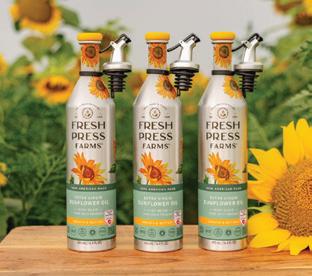
Suggested retail price: $8.99 per 16.4-fl uid-ounce bottle
Locally sourced and cold pressed, Fresh Press Farms speci cally uses high-oleic sunower seeds for its oil, which contains healthier monounsaturated fats and lower saturated fats. Fresh Press Farms’ oil is the only sun ower oil certi ed Heart Healthy by the American Heart Association, and it’s free from llers or arti cial preservatives. Additionally, cold-pressed oils are never overheated and never use chemicals, allowing the company to produce its oil with the highest avors, aromas and health bene ts. For packaging, Fresh Press Farms uses proprietary aluminum bottles that are not only sustainable, but also endlessly recyclable.
Food Club Spiral Sliced Ham
Suggested retail price: $2.99 per pound
Spiral Sliced Honey Ham, Brown Sugar Ham, Deluxe Honey Glazed Ham and Deluxe Brown Sugar Glazed Ham are all available in natural juices to provide avorful holiday options at an own-brand price. Festive foil overwraps, color-coded for easy selection based on each avor pro le, encircle each holiday ham. By aggregating Food Club Spiral Sliced Holiday Ham purchases, Topco positioned its members to win on quality, price and selection. Subsequently, Topco member stores were not only able to compete with the national brands, but also with private label brands at larger chain stores.
Forager Project Honey Alternative Probiotic Cashewmilk Yogurt
Suggested retail price: $6.99 per 24-ounce container
Forager Project Honey Alternative Cashewmilk Yogurt is the rst honey-, bee- and dairy-free yogurt. Instead of using real honey, it uses fruit juices and organic cane sugar










Full Circle Market Breakfast Rounds
Suggested retail price: $4.99 per 15.9-ounce package
thrive and sends a message to consumers that caring for bees equates to caring for the planet. This vegan yogurt is made with cashews that are always organic, ethically sourced and sustainably farmed. Forager’s plant-based yogurt is also free of gluten and soy.
Fresh Cravings
Fire Roasted Salsa
Suggested retail price: $3.43 per 14-ounce tub
Fresh Cravings’
versatile salsas feature unique avor pro les in both taste and texture. With two new avors, Fire Roasted Red and Fire Roasted Avocado Salsa, Fresh Cravings captures the smoky taste pro le that consumers are seeking. Avocado in chilled salsa is rare as it is, but Fresh Cravings ups the ante by using a blend of subtly sweet tropical and creamy Hass avocados to create a unique taste. This is coupled with zesty roasted tomatillos, adding a tangy avor. Using creative branding that includes fun colors and imagery evoking plants, Fresh Cravings products pop in the produce section, differentiating them from others in the category.

According to Mintel, 54% of shoppers are actively looking for better-foryou breakfast items. Available in apple, blueberry or cranberry avors, Topco’s Full Circle Market Breakfast Rounds now provide shoppers with a convenient choice within the fresh bakery section. Although some shoppers might not intuitively consider shopping the in-store bakery for their healthier breakfast needs, Breakfast Rounds are made with real fruit and offer a good source of ber and 6 grams of protein per serving. In addition to being a ready-to-go breakfast option, they’re also ideal as a better-for-you afternoon snack. Further, Breakfast Rounds offer a change of pace from traditional bakery offerings.

Gold Standard Ready To Drink Protein Shake
Suggested retail price: $8.49 per 4-pack of 11-fl uid-ounce cartons

The Gold Standard Ready To Drink Protein Shake offers the same quality as the brand’s 100% Gold Standard Whey protein powder, but in an on-the-go format. The convenient item features 24 grams of protein per serving, 24 essential vitamins and minerals, and only 1 gram of sugar. A 360-degree marketing campaign included in uencers across the NIL (name, image and likeness) college athlete space, while the More of You in You campaign featured U.S. pro tennis star Taylor Fritz touting the protein shake as his preferred recovery drink. Additionally, a large sampling program kicked off this summer with Volo Sports, and a fall college sampling program is also scheduled.

20 progressivegrocer.com
Good Foods Grab & Go Chunky Guacamole

Suggested retail price: $3.99 per 2.75-ounce pack
Grab & Go Chunky Guacamole addresses increased consumer interest in convenient, better-for-you snacks without sacri cing avor and freshness. Available in a single-serve container and packaged using high-pressure processing (HPP) technology, the product features Good Foods’ Chunky Guacamole paired with corn tortilla chips. It’s Non-GMO Project Veri ed, vegan and gluten-free, and contains about 180 calories. The use of HPP technology to seal in avor and freshness without the use of preservatives also helps differentiate the product from its closest competitors. Overall, Grab & Go Chunky Guacamole is empowering consumers to feel good about snacking on the go throughout the day.
Good2Grow Snackers
Suggested retail price: $5.99 per 2-ounce package
Snackers combine fun and nutrition with wholesome ingredients and kid-favorite character tops from Disney, Nickelodeon, Hasbro, Comcast Universal and more. The single-serve packages feature better-for-kids ingredients like baked oat-and-wheat crackers in two “kid-approved” avors — cinnamon and chocolate — while the reclosable lids allow for mess-free, on-the-go snacking. Good2grow’s relationships with its licensed partners means that, after snack time, the product can function as a reusable toy, which represents an ongoing value to parents. Also, the brand’s most engaged consumers can collect its various characters, creating a long-lasting experience for families well beyond Good2grow’s rst touchpoint.

Gustare Vita Alfredo Macaroni Bowl
Suggested retail price: $4.99 per 14-ounce bowl
Gotham Greens Dips
Suggested retail price: $6.49 per 6.5-ounce container
Available in Green Goddess, Spinach Artichoke, Tzatziki and Green Harissa avors, the Gotham Greens Dips line features various fresh greens and herbs to create herbaceous and bold twists on some well-known dip avors.
Gotham Greens Dips are 100% plant-based, dairy- and gluten-free, Non-GMO Project Veri ed, and never heated. There are also no arti cial llers, avors, gums or preservatives. While most plant-based dips contain water as the rst or second ingredient, Gotham Greens Dips contain a cauli ower-and-chickpea blend for a creamy texture that rivals that of dairy-based products. With its dips, vertical-farming company Gotham Greens is offering complementary products across the store, driving overall brand awareness and cross-purchase.
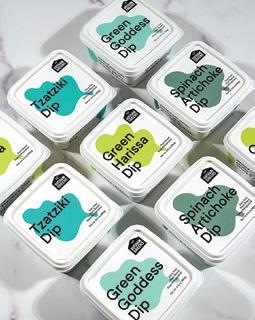
Hy-Vee’s private label Gustare Vita Alfredo Macaroni Bowl is the only authentic Italian all-in-one prepared meal in its category. Made with high-quality ingredients sourced directly from Italy, the item surpasses comparable items that are too often lled with preservatives and bland avors. The entrée not only takes avor to the next level, but also offers convenience and sustainability. It comes in a compostable bowl, accompanied by a fork, and is ready to eat after a mere 8 minutes in the microwave, making it an easy and affordable solution for busy consumers. It’s performing so well that Hy-Vee is adding two gluten-free pasta options to the line.

with


























Harvest Snaps Selects Baked Navy Bean Snacks




Suggested retail price: $4.99 per 4.2-ounce bag
Calbee America’s Harvest Snaps Selects brings a new set of health-conscious consumers to the salty snack aisle with its Navy Bean Snacks. The item offers the best of both worlds — better-for-you plant-based nutrition and great taste. With avors like zesty Loaded Taco, smooth and spicy White Cheddar Jalapeño, and tangy-sweet Honey Dijon, the crunchy snack line is also ideal for those with food allergies. It’s gluten-free and vegetarian-friendly, and doesn’t contain wheat, soy, nuts, peanuts, eggs, arti cial avors or preservatives. To maximize taste and nutritional value, Harvest Snaps sources its navy beans whole and mills them in-house, providing a hearty 4-5 grams of plant protein and 3 grams of ber per serving.
Hope Foods Hummus

Suggested retail price: $4.89 per 8-ounce container
Hope Foods Hummus is made by the rst and only dip and spread brand to be Certi ed Plastic Neutral. By partnering with rePurpose Global, the company ensures the recovery of the equivalent amount of plastic used in its product packaging. Meanwhile, the hummus itself is made from organic and non-GMO ingredients. Hope Foods uses high-pressure processing and cold-pressure technology to maintain a homemade fresh taste without compromising texture or avor. Its hummus also offers health bene ts through the addition of organic axseed oil, making it functional and nutritious with a natural source of plant-based omega-3s.
21
In Good Hands Protein Pu s
Suggested retail price: $3.69 per approx. 1-ounce bag

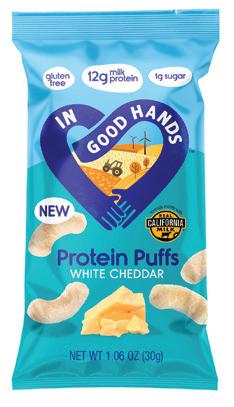

As one of the rst milk protein-packed savory snacking options in the chip aisle, In Good Hands Protein Puffs push the limits of better-for-you snacking options. The snack is created by dairy farmers who use the nutritional bene ts of milk protein from Real California Milk. Consequently, each gluten-free bag of puffs provides a whopping 12 grams of milk protein, along with only 1 gram of sugar per serving. Designed for grab-and-go convenience, the puffs feature a cheesy, crunchy texture that delivers on avor, making them a healthier — but still tasty — alternative to other cheesy snack options on the market.
Jeni’s Biscuits With The Boss Ice Cream
Suggested retail price: $12 per pint


Jeni’s Splendid Ice Creams teamed with Apple and Warner Bros. Discovery Global Consumer Products on Biscuits With The Boss, a limited-edition ice cream inspired by the Emmy award-winning series (and PG’s unof cial favorite TV show) “Ted Lasso.” Referencing the quirky soccer coach’s daily ritual of bringing homemade shortbread cookies for his employer, the salty-sweet offering was packed with shortbread cookie crumbles for a creamy, crumbly eating experience. The most successful launch in Jeni’s history, Biscuits With The Boss garnered considerable attention not only from national media and consumers, but also from the program’s actors themselves, creating a true cultural moment.

Kevin’s Natural Foods Beef Strogano

Suggested retail price: $13.99 per 26-ounce package

A convenient meal ready in just ve minutes, Kevin’s Paleo Certi ed, gluten-and soyfree Beef Stroganoff with no re ned sugar pairs the brand’s signature avorful sauce with ultra-tender sous-vide top sirloin beef and cauli ower pasta that looks and tastes like traditional noodles. The product was promoted via social media as well as traditional public relations efforts and traditional media, bringing new health-conscious shoppers to the category with the promise of healthy eating without compromise. Additionally, the clean packaging stands out in a busy section of the store.
Kind Soft Baked Granola
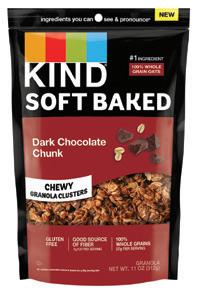

Suggested retail price: $5.99 per 11-ounce package
La Terra Fina Jalapeño Pepper-Jelly Dip & Spread
Suggested retail price: $5.49 per 10-ounce container


Sweet, tangy and somewhat spicy, this dip blends smooth cream cheese with sweet and sour cherries, cranberries and jalapeño peppers. Key to the versatile item’s success is its fusion of avors as Asian foods and spices continue to grow in popularity in the United States.
Jalapeño Pepper-Jelly Dip & Spread was one of four new avors launched in spring 2023, with a strong retail distribution plan launched in time for the busy summer entertaining season. Like all La Terra Fina products, Jalapeño Pepper-Jelly Dip & Spread contains no preservatives or arti cial colors or avors and comes in a fully recyclable container.
Featuring 100% whole grain oats as its top ingredient, Kind Soft Baked Granola has a unique soft and chewy texture, in contrast to the crunchy granola in the brand’s Healthy Grains granola portfolio. The gluten-free, low-sodium product also features such craveable ingredients as dark chocolate chunks, creamy peanut butter and chopped nuts for an indulgent breakfast experience. Soft Baked Granola was supported through a 360-degree integrated marketing campaign encompassing dedicated product and lifestyle assets, paid media and search campaigns, and earned media outreach. There were also speci c in-store shippers for the product and a robust digital-shelf presence on Kind’s Amazon page.

La Clare Rolled Blueberry Vanilla Goat Cheese

Suggested retail price: $8.99 per 8-ounce package
Made by the only 100% domestically produced goat cheese brand in the country, La Clare Rolled Blueberry Vanilla Goat Cheese starts with fresh, local Wisconsin goat milk, delivering a avor that’s both familiar and appealing to many consumers. La Clare promoted Rolled Blueberry Vanilla Goat Cheese through its social media accounts, as well as targeted digital advertising to drive awareness to the stores that have the product available for sale. The cheese comes in a clear plastic lm that displays the entire log so consumers can see what they’re purchasing, with an easy-peel lm for convenience and ease in opening.
LesserEvil Space Balls-Interstellar Cheddar
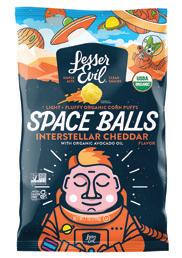
Suggested retail price: $5.99 per 7-ounce bag
McDaniel’s Café Espresso
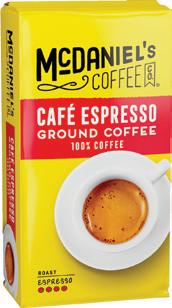
Suggested retail price: $2.49 per 8.83-ounce package
According to Save A Lot, McDaniel’s Café Espresso’s high quality and rich avor have enabled it to meet — and often beat — national-brand competitors in taste tests. Then there’s the price, which comes in at half of what customers normally pay for national-brand equivalents. Further, the brick pack’s bright, bold colors guarantee that it stands out on the shelf. The rollout of McDaniel’s Café Espresso was part of a complete relaunch of Save A Lot’s ground coffees. To build on the product’s success, the retailer’s category team is looking into creating an instant espresso item as a companion to the current offering.
Nasoya Plantspired Korean-Inspired Sweet Chili Toss’ables
Suggested retail price: $4.99 per 7-ounce pouch
Furthering
LesserEvil’s expansion into kid-friendly offerings, Interstellar Cheddar Space Balls feature nondairy seasoning that adds cheesy avor to air-puffed whole grain organic corn balls swirled with avocado oil and Himalayan salt. The Certi ed Organic, Non-GMO Project Veri ed, gluten-free, minimally processed snack offers a better-for-you alternative to a mainstream favorite, while its sustainably sourced ingredients support LesserEvil’s mission to make products that are better for both people and the environment. The brand is supporting Space Balls through various marketing channels, including public relations efforts, social media marketing and advertising strategies. Additionally, the biodegradable packaging features an innovative space-themed design.
Love Beets Perfectly Pickled Sliced Beets

Suggested retail price: $4.99 per 6.5-ounce package
Nasoya’s Plantspired Korean-Inspired Sweet Chili Toss’ables makes plant-based eating easy for busy consumers. Featuring bite-sized pre-baked tofu cubes marinated in an aromatic sauce, the Non-GMO Project Veri ed, gluten-free and USDA Certi ed Organic product contains a hefty 11 grams of plant-based protein per serving and can be added to rice, noodles, salads or stir-fries. Unlike other plant-based proteins that can be intimidating or inaccessible, the product can be enjoyed hot or cold. Sweet Chili Toss’ables were featured prominently on Nasoya’s social channels, which showcased the product’s convenience and versatility. The brand is continuing to develop other plant-based products highlighting Asian-inspired avors.

Nature’s Premium Fruit Pearls

Created for beet fans and novices alike, Love Beets’ organic Perfectly Pickled Sliced Beets are steam-cooked until tender, peeled, sliced and ready to eat. Boasting a shelf-life guarantee of 36 days, the USAgrown product is a fresh and convenient option for consumers seeking quick, easy and better-for-you solutions. The slightly sweet premium beets can be added to salads, bowls and sandwiches, or just eaten right out of the resealable package. Love Beets’ lineup is found in the refrigerated value-added produce section at mainstream retailers, and it’s the only brand to offer a marinated/ pickled beet option in a fresh-pack format.
and better-for-you solutions. The slightly sweet
Marquis Pineapple Passion

Suggested retail price: $2.91 per 12-fl uid-ounce can

Suggested retail price: $5.99 per 9.2-ounce package This next-generation innovation in frozen fruit offers an all-natural mix of real fruit or fruit and creamy yogurt, backed by the USDA and Smart Snack approved. Suitable for nearly every diet, the gluten-free, lowfat treat contains no arti cial colors, avors or sweeteners, and has just 65-70 calories per serving. According to manufacturer Citrapac Inc., the product has added incremental and impulse sales to the “boring” frozen fruit category with impulse avors and convenient servings of an anytime healthy snack. Citrapac has promoted Fruit Pearls through social media, advertising and product sampling, as well as via online and store-level promotions.
Marquis Pineapple Passion is one of the latest additions to the brand’s lineup of lightly caffeinated sparkling functional beverages, amplifying the brand’s commitment to encourage responsible caffeine consumption among consumers. The tropical fruit-forward avor delivers a balanced lift with just 100 milligrams of caffeine per serving. Offering an organic blend of caffeine from yerba maté, green coffee and green tea, Pineapple Passion delivers 100% of essential B vitamins, four antioxidants and more vitamin C than an orange. Following its winter launch, it quickly became the best-selling Marquis avor, driven by the unique avor combination of pineapple and passion fruit.
24 progressivegrocer.com


Instant Gratification
AN INSTANT POWER EXECUTIVE EXPLAINS WHAT MAKES HIS COMPANY’S PLUMBING AND CLEANING PRODUCTS STAND APART FROM THOSE OF COMPETITORS.
By Mike Duff
Instant Power Corp. is looking to unblock drains that just don’t work like they used to. The company’s range of products gives consumers the chance to deal with multiple drain and septic issues by providing a broad range of solutions to plumbing problems. The Instant Power Drain Opener lineup includes a Hair & Grease Drain Opener, a Hair Clog Remover, and, the company notes, a pair of heavy-duty items, one 10 times more potent than common drain openers and the other 36 times more powerful. Instant Power also offers consumers Drain Maintainers and Sewer & Septic products. The company has additionally developed a portfolio of cleaning products that includes items for showers, toilet tanks, washing machines, dishwashers, disposals and drains, as well as an Extreme Stain & Odor Remover designed for the sort of household challenges associated with family and pet activity.
According to Grant Stallknecht, VP sales at Dallas-based Instant Power Corp., the product formulations that the company has created can tackle difficult-to-address household drain and cleaning dilemmas where others might falter. Instant Power launched 55 years ago and has grown its availability to a range of retailers, including some of the largest in the United States. The company backs its product with a 100% money-back guarantee, but that isn’t all: On social media, it offers fun and instructive information on drain and cleaning problems, with its products offered as the solutions. On its website, Instant Power provides a connection to The Drain Experts with a page that features a form through which consumers can ask questions about Instant Power products or request a refund based on the company’s guarantee. All customers need to do is fill out the form, attach an image of the original receipt and get their refund. As such, Instant Power expresses confidence in its products, supported as they are by product information, advice and a means to easily address issues.
Following is a conversation between Progressive Grocer and Stallknecht on what differentiates Instant Power from other cleaning brands.
Progressive Grocer: What is the first thing anyone should understand about the Instant Power line of products?
Grant Stallknecht: At Instant Power, we focus on drain care products, and, as the No. 3 national brand, we carry the strongest nonacid product on the market.
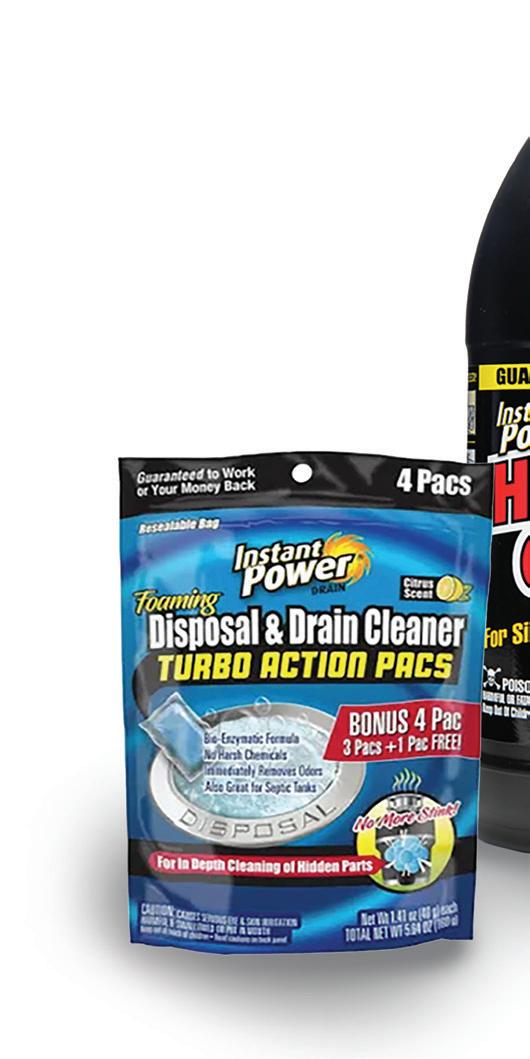
PG: What particular advantages do Instant Power products offer?
GS: Our formulation is superior to many of the brands out there today: We actually work, or you get your money back!
PG: How do the products provide the results they do?
GS: We use a dual-hydroxide formulation that will dissolve the drain-clogging material for as long as it is in the drain.
PG: How do Instant Power products compare with and differ from the competition?
GS: The difference is formulation and time in the drain.
PG: What do grocers tell you about what’s happening in the household essentials aisle when it comes to sales trends and consumer behavior?
GS: Cleaning is still a vital category that, when purchased, increases overall basket size.
PG: How did the Instant Power product line launch and expand, and when did it first reach the consumer market?
26 progressivegrocer.com NONFOODS CPG Q&A
“Anyone that has drains is a customer; at some point there will be a clog.”
—Grant Stallknecht, Instant Power Corp.
GS: We have been in the consumer market since 1968, primarily in the hardware/home center market. Over the last 20 years, we have expanded in mass, grocery, and farm and ranch.
PG: How safe are Instant Power formulations?
GS: Very safe when following the directions. Vinegar is a good neutralizer if needed.
PG: Are all of the products created for the same retail channels, or are some specialized for particular distribution?
GS: We have products for retail and commercial, and each is designed for that end user.
PG: Who are the products’ core customers, or does Instant Power target multiple key consumer groups?
GS: Anyone that has drains is a customer; at some point there will be a clog. Ninety-five percent of all clogs are caused by hair.
PG: How does Instant Power do its consumer outreach in terms of traditional marketing and/or other channels
to the consumer, such as social media?
GS: We use Facebook and Instagram. We also have online programs for many retailers.
PG: What responses have consumers had to the Instant Power product line?

GS: Our reviews are outstanding, which leads to repeat purchases.
PG: What do consumers particularly emphasize in their feedback?
GS: Many have standing water in their drain. They pour [our product] in, wait eight hours, and then hear a swish of the water releasing, and the clog is gone. They love hearing that swish!
PG: What does the future hold for Instant Power?
GS: We continue to innovate and find more ways to help keep drains flowing freely. A new line of products will be launched soon!
PROGRESSIVE GROCER September 2023 27
Instant Power's broad range of products gives consumers the chance to deal with multiple drain and septic issues.
Niman Ranch Grass-Fed Pulled Angus Beef
Suggested retail price: $13.99 per 10-ounce package
Made from 100% grass-fed and - nished Angus beef from Certi ed Humane independent family ranchers in the United States using no antibiotics or hormones, this convenient product contains just three other natural ingredients — sea salt, vinegar and rosemary — with no sugar or additives. Not only is the beef 100% pasture raised, but the microwaveable packaging is also compostable for a lower environmental footprint. While most comparable retail options are pre-mixed with a barbecue sauce, Niman Ranch omits the sauce, enabling more menu options. The company offers virtual ranch tours via QR codes promoted to consumers through shelf talkers and other merchandising.

NotChicken Crispy Patties
Suggested retail price: $7.99 per 12-ounce package of four patties Made from such ingredients as fava beans, bamboo and peaches, NotChicken is a crispy, juicy plant-based chicken patty made possible by Giuseppe, NotCo’s proprietary AI technology, which analyzes thousands of plants in its database to accurately replicate the taste, texture and even smell of animal-based protein. The launch lls a void in the natural product market by offering an alternative that not only tastes good, but is also better for the planet: The NotChicken production process uses 73% less energy, 86% less water and 73% fewer carbon dioxide emissions than the traditional chicken production process, according to a NotCo internal audit.

Nudge Co ee Bombs
Suggested retail price: $2.99 per 1.94-ounce container
With Nudge Coffee Bombs, The Whole Coffee Co. has created coffee in confection form. Combining high-quality 100% arabica coffee with cocoa butter and other simple ingredients through a patented process, the company offers all of the bene ts of coffee — natural caffeine, antioxidants and ber — in a thin cane-sugar shell. Additionally, the portable product comes in such tempting avor pro les as Caramel Macchiato, Vanilla Latte and Hazelnut Crème, all at just 3 grams of sugar per serving. At one large retailer, Nudge drove 22% incrementality in the snack category through basket building by shoppers and converting new consumers to the category.

Nütrl Cranberry Vodka Seltzer Variety Pack
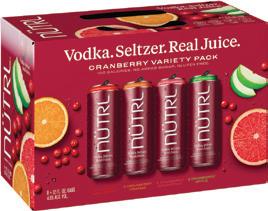
Suggested retail price: $16.99 per 8-pack of 12-fl uid-ounce cans
Anheuser-Busch’s Nütrl Cranberry Vodka Seltzer is made with just three simple ingredients: real vodka, real juice and sparkling water. Containing only 100 calories per serving, the gluten-free adult-beverage line enables consumers to enjoy their No. 1-preferred vodka mixer avor in a premium ready-to-drink format offering a range of options: Classic Cranberry, Cran Orange, Cran Grapefruit and Cran Apple. To drive brand awareness, A-B invested in media across social, streaming, out-of-home and digital channels, including a national campaign starring “SNL” star Chloe Fineman, and also executed local sampling programs and activations at retail accounts, and local activations through event sponsorships.
Panang Bitchin’ Sauce
Suggested retail price: $6.99 per 8-ounce container
A gluten-free, vegan, plant-based and low-carb product made with raw California almonds and fresh curry paste, Panang Bitchin’ Sauce can be dipped, spread or poured on consumer’ favorite savory foods. Additionally, the product is packaged using high-pressure processing, a sustainable technology that extends the shelf life of the item by four to six months without adding preservatives while reducing potential food waste. In-store demos allowed customers to try the product and engage with the Bitchin’ staff to learn more. The company has also created long-lasting organic relationships with such well-known in uencers as Kylie Jenner, Ruby Rose and Heidi Montag.
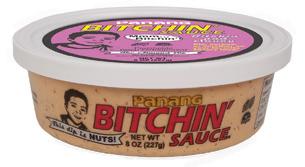
Paws Happy Life Green Dental Chews Dog Treats

Suggested retail price range: $12.99-$15.99 per 14- to 18-ounce package
Topco’s chewy dog treats promote fresh breath and remove plaque and tartar while also being wheat-free and easily digestible. They come in packages for small, medium and large dogs, and the resealable plastic pouches help ensure freshness. Topco’s product offers all of the bene ts of the national brand, along with considerable cost savings, and is supported by online, instore and in-aisle promotions to help drive awareness and purchase intent.
Nurishh Incredible Dairy Animal Free Cream Cheese

Suggested retail price: $4.99 per 6.5-ounce container
Nurishh Incredible Dairy Animal Free Cream Cheese provides an alternative to traditional dairy spreads. Crafted with food tech startup Perfect Day using precision fermentation, it delivers the same taste and texture as dairy cream cheese, contains no cholesterol or lactose, and appeals to health- and environmentally conscious consumers who prioritize taste and nutrition. The product line comes in three varieties: Original, Chive & Onion, and Strawberry. Bel Brands USA promoted Nurishh Incredible Dairy Animal Free Cream Cheese through a robust marketing and PR campaign, educating consumers about animal-free dairy in tandem with an incentive for those who made the switch.
28 progressivegrocer.com
Merchandising is more than fito ut and fixtures It’s the art of creating an attractive, well-organized retail presentation. As with any artistic composition, a wide variety of tools may be used to create your masterpiece. In retail Visual Merchandising, a gondola, pegboard, slatwall or shelf is your blank canvas When combined with tools such as display hooks, label and sign holders, bar merchandisers, tray systems, and merchandising accessories, there are endless ways to effectively display all kinds of products and inspire your target audience to make a purchase. As one of the world’s top retail fixture manufacturers, Trion offers a generous supply of over 25,000 components and over 50 years of experience using them to execute precise planogram solutions, store designs and retail displays. Call us to turn your vision into an inspirational retail masterpiece.
DISPLAY AND SCAN HOOKS
LABEL HOLDER SYSTEMS
DIVIDER AND PUSHER SYSTEMS
BAR MERCHANDISING SYSTEMS
COOLER MERCHANDISING SYSTEMS

THE
OF MERCHANDISING ® THE
WWW.TRIONONLINE COM/ART | 800-444-4665 ©2015 Trion Industries, Inc. THE A
T OF MERCHANDISINGT M
ART
AR T OF MERCHANDISINGTM
R
Hooks | sH elf Merc H andising | l abeling WWW.T riononline co M/ ar T | 800-444-4665 ©2023 Trion Industries, Inc.
THE ART OF MERCHANDISING ®
THE ART OF MERCHANDISIN G
Introducing ZIP Track® Merchandising System for Beverage & Storewide




For Grab-and-Go Beverage Sales
Zip Track® Beverage System
The forecast is a cold cooler front when you use Trion’s Air Flow Baffle in coolers. Product temperature can be difficult to maintain at the front of a cooler. This Air Flow Baffle ensures that cold air is forced forward to keep items at their ideal temperature. Use as part of your cooler outfitting strategy, along with WonderBar ® Bar Merchandisers and hooks, EWTTM Expandable Wire Tray System, and cooler capable Clear Scan® label holders.


Call 800-444-4665 | TrionOnline.com
Merchandise all size drinks from mini Red Bull® cans to oversized Gatorade® bottles. ZIP Track® is the most versatile and cost-effective Grab-and-Go system available on the market. Use actual product to set lane width from 2" to 3 3/4 " Reset lane width on set-up in less than 30 seconds. Shelf-based and coolerready, this anchored system billboards product for easy selection and fast sale. ZIP Track® forwards and faces product at all times. Quickly add lanes with this easy to install and adjust system. ZIP Track® offers a wide range of adjustability for this ever-evolving beverage category and changing package designs.
For Storewide and Grocery Sales Zip Track® Merchandiser
It’s not just for coolers or beverages. Use ZIP Track® in multiple categories to showcase many different types of product. This is the most versatile system, of its kind available on the market. Manufactured from durable, modern plastics, it provides extended merchandising life. ZIP Track® offers a wide range of adjustability. Custom spring tensions and lane depths are available to fit any and all shelf and product needs.
dips, puddings, ice cream, single-serve foods, and more. Our small Adjustable Merchandising Tray (AMT) fits a range of 4- to 6-ounce cups; the medium AMT organizes mid-range offerings; and the large AMT gives ice cream lovers pause to browse and choose a pint of their favorite flavor (hmmm why not get both Cherry Vanilla and Rocky Road?). This manual-feed tray ensures that products remain faced and accessible. Time to re-stock? Just lift out and refill. Add Clear Scan® Label Holder, and you’re finished! Call 800-444-4665 | TrionOnline.com
WonderBar EWT Large
Clip It! Installs in an Instant Zip Track® Components
ZIP Track ® components clip on the front rail allowing easy adjustment. Lanes can slide on the rail even when full or to add additional facings.
If you think the WonderBar EWT is great, wait till you meet its big brother! Oversized just like some of your products, this weightlifter stays strong on both metal and open wire shelves and bar. One-piece installation means you can drop this bad boy right into place, adjust as needed, and watch the revenue increase. The EWT takes over from there, automatically feeding product to the front and billboarding merchandise for maximum visibility. Call 800-444-4665 | TrionOnline.com
Zip It! Setting Width is a Breeze
Zip Track® Easy install
Use actual product to set lane width from 2 " up to 3 3/4 ". Slide product front-to-back, along the lane, to “ZIP” each track together in final position.
Super Hooks!
Fill It! With a Wide Range of Products
Zip Track® Sells it All
WonderBar Displays are the versatile heroes of the Trion product family, coming to the rescue when you need muscle and good looks to merchandise items of all sizes. These Bar Hooks can lift heavy loads in their capable arms. Display or Scan, Saddle Mount or Plug in, there are Trion WonderBar Hooks for every need.
Fill it with product. ZIP Track® maintains its width accurately for the entire depth of facing without the need for a rear anchor system.
©2019 Trion Industries, Inc.
HOOKS | lAbElING | SHElF & COOlER MERCHANDISING 800-444-4665 | info@triononline.com triononline.com/Art
® Create Your Own Merchandising Masterpiece with Trion Fixtures
© 2023 Trion Industries, Inc.
THE ART OF MERCHANDISIN G ®
Create Your Own Merchandising Masterpiece with Trion Fixtures
Create Your Own Merchandising Masterpiece with Trion Fixtures
THE ART OF MERCHANDISIN G ®
Create Your Own Merchandising Masterpiece with Trion Fixtures
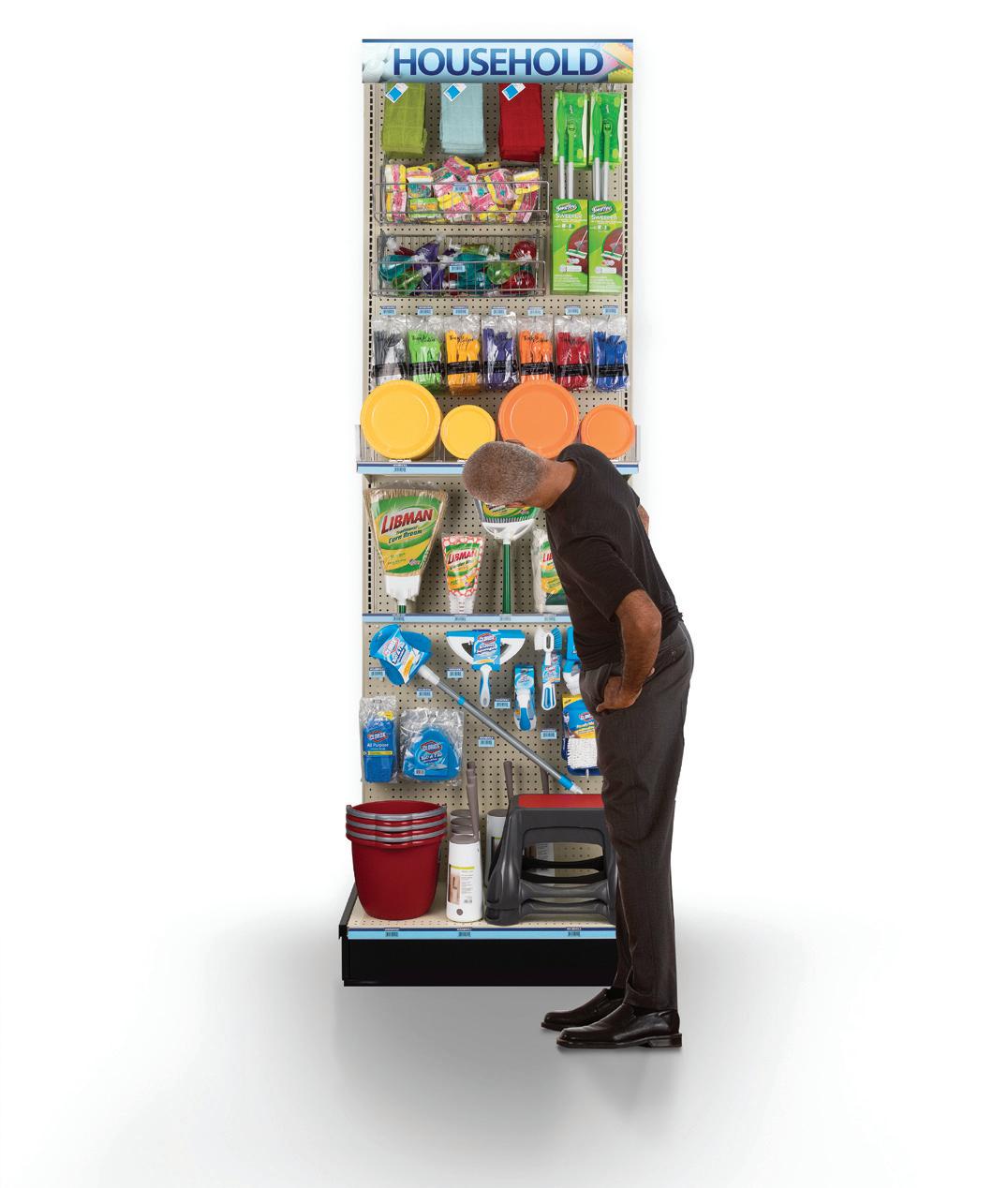
The Problem Solver Endless Baskets
The Problem Solver Endless Baskets
Cold Front Forecast Air F low Baffle
When Visibility is Your Goal Clear Acrylic Dividers
Oversize? No Problem!
When Visibility is Your Goal Clear Acrylic Dividers
The number of products you can effectively, attractively merchandise in these baskets is, well, endless, as is the length and uses. Mount level or in gravity-feed mode from pegboard or slatwall, or place on shelves or table tops. Pair the baskets with hang tags, efficiently displaying both products and prices. Customize your baskets with handy dividers to create exactly the compartmentalization you need.
WonderBar® EWTTM Large
The Problem Solver Endless Baskets
The Problem Solver Endless Baskets
Z ip Track ® Merchandiser
The number of products you can effectively, attractively merchandise in these baskets is, well, endless, as is the length and uses. Mount level or in gravity-feed mode from pegboard or slatwall, or place on shelves or table tops. Pair the baskets with hang tags, efficiently displaying both products and prices. Customize your baskets with handy dividers to create exactly the compartmentalization you need.
The forecast is a cold cooler front when you use Trion’s Air Flow Baffle in coolers. Product temperature can be difficult to maintain at the front of a cooler. This Air Flow Baffle ensures that cold air is forced forward to keep items at their ideal temperature. Use as part of your cooler outfitting strategy, along with WonderBar ® Bar Merchandisers and hooks, EWTTM Expandable Wire Tray System, and cooler capable Clear Scan® label holders.
When Visibility is Your Goal Clear Acrylic Dividers
Call 800-444-4665 | TrionOnline.com
Call 800-444-4665 | TrionOnline.com
The number of products you can effectively, attractively merchandise in these baskets is, well, endless, as is the length and uses. Mount level or in gravity-feed mode from pegboard or slatwall, or place on shelves or table tops. Pair the baskets with hang tags, efficiently displaying both products and prices. Customize your baskets with handy dividers to create exactly the compartmentalization you need.
Call 800-444-4665 | TrionOnline.com
Call 800-444-4665 | TrionOnline.com
The number of products you can effectively, attractively merchandise in these baskets is, well, endless, as is the length and uses. Mount level or in gravity-feed mode from pegboard or slatwall, or place on shelves or table tops. Pair the baskets with hang tags, efficiently displaying both products and prices. Customize your baskets with handy dividers to create exactly the compartmentalization you need.
Call 800-444-4665 | TrionOnline.com
Use ZIP Track® storewide to organize various types of cleaning products, insect repellent and various other household items. It is the most versatile system of its kind on the market. Easy to install, ZIP Track® components clip on a front rail allowing lanes to adjust quickly, even when full or to add additional facings. Use actual product to set lane width from 2" up to 3 3/4 " Slide product front-to-back to “ZIP” each track together. ZIP Track® offers a wide range of adjustability for everevolving package designs.

Cooler Capable AMT®
Fast and Easy Attached-Back HooksTM
speeding labor intensive projects. Because the hooks are already assembled, you can display merchandise as quickly as you can say “profits.” Once installed, these hooks come apart easily, making merchandising changes in tight displays fast and easy. Reinforced to host even heavy items, these hooks are available in standard, medium and heavy gauge frontwires with engineering grade plastic backplates to provide durable and attractive ways to keep your merchandise accessible.
Fast and Easy Attached-Back HooksTM
straight-entry hooks arrive already assembled – a dream come true for speeding labor intensive projects. Because the hooks are already assembled, you can display merchandise as quickly as you can say “profits.” Once installed, these hooks come apart easily, making merchandising changes in tight displays fast and easy. Reinforced to host even heavy items, these hooks are available in standard, medium and heavy gauge frontwires with engineering grade plastic backplates to provide durable and attractive ways to keep your merchandise accessible.
The way to profits is clear when customers can spot and browse neatly displayed, upscale merchandise. Adjustable, multi-functional dividers allow you to customize depth and change the width of displays just as fast as new products are delivered. Sturdy, clear presentation keeps products looking their best, highlighting the colors, options, sizes, quality, and billboarding brands. Trion’s Clear Acrylic Divider Systems are among the best looking and adaptable merchandising systems.
The way to profits is clear when customers can spot and browse neatly displayed, upscale merchandise. Adjustable, multi-functional dividers allow you to customize depth and change the width of displays just as fast as new products are delivered. Sturdy, clear presentation keeps products looking their best, highlighting the colors, options, sizes, quality, and billboarding brands. Trion’s Clear Acrylic Divider Systems are among the best looking and adaptable merchandising systems. Call 800-444-4665 | TrionOnline.com
When Visibility is Your Goal Clear Acrylic Dividers

If you think the WonderBar EWT is great, wait till you meet its big brother! Oversized just like some of your products, this weightlifter stays strong on both metal and open wire shelves and bar. One-piece installation means you can drop this bad boy right into place, adjust as needed, and watch the revenue increase. The EWT takes over from there, automatically feeding product to the front and billboarding merchandise for maximum visibility. Call 800-444-4665 | TrionOnline.com
The way to profits is clear when customers can spot and browse neatly displayed, upscale merchandise. Adjustable, multi-functional dividers allow you to customize depth and change the width of displays just as fast as new products are delivered. Sturdy, clear presentation keeps products looking their best, highlighting the colors, options, sizes, quality, and billboarding brands. Trion’s Clear Acrylic Divider Systems are among the best looking and adaptable merchandising systems. Call 800-444-4665 | TrionOnline.com
The way to profits is clear when customers can spot and browse neatly displayed, upscale merchandise. Adjustable, multi-functional dividers allow you to customize depth and change the width of displays just as fast as new products are delivered. Sturdy, clear presentation keeps products looking their best, highlighting the colors, options, sizes, quality, and billboarding brands. Trion’s Clear Acrylic Divider Systems are among the best looking and adaptable merchandising systems. Call 800-444-4665 | TrionOnline.com
Call 800-444-4665 | TrionOnline.com
WonderBar® Hooks

Extend Your Revenue Pegboard Extenders
Super Hooks!
Extend Your Revenue Pegboard Extenders
You read that right. These two-piece straight-entry hooks arrive already assembled – a dream come true for speeding labor intensive projects. Because the hooks are already assembled, you can display merchandise as quickly as you can say “profits.” Once installed, these hooks come apart easily, making merchandising changes in tight displays fast and easy. Reinforced to host even heavy items, these hooks are available in standard, medium and heavy gauge frontwires with engineering grade plastic backplates to provide durable and attractive ways to keep your merchandise accessible.
Neatly and effectively display cooler and freezer items, including yogurt, dips, puddings, ice cream, single-serve foods, and more. Our small Adjustable Merchandising Tray (AMT) fits a range of 4- to 6-ounce cups; the medium AMT organizes mid-range offerings; and the large AMT gives ice cream lovers pause to browse and choose a pint of their favorite flavor (hmmm why not get both Cherry Vanilla and Rocky Road?). This manual-feed tray ensures that products remain faced and accessible. Time to re-stock? Just lift out and refill. Add Clear Scan® Label Holder, and you’re finished! Call 800-444-4665 | TrionOnline.com
Call 800-444-4665 | TrionOnline.com
Call 800-444-4665 | TrionOnline.com
You read that right. These two-piece straight-entry hooks arrive already assembled – a dream come true for speeding labor intensive projects. Because the hooks are already assembled, you can display merchandise as quickly as you can say “profits.” Once installed, these hooks come apart easily, making merchandising changes in tight displays fast and easy. Reinforced to host even heavy items, these hooks are available in standard, medium and heavy gauge frontwires with engineering grade plastic backplates to provide durable and attractive ways to keep your merchandise accessible.
Call 800-444-4665 | TrionOnline.com
Call 800-444-4665 | TrionOnline.com
Extend Your Revenue Pegboard Extenders
Extend your opportunities to increase revenue with Trion’s pegboard extenders. Use them to layer display surfaces so you can simultaneously show tall and short items. Commonly used to merchandise mops, brooms, long handled tools and more, with cross sells and accessories directly in front. Pegboard extenders extend your merchandising reach.
WonderBar® Displays are the versatile heroes of the Trion product family, coming to the rescue when you need muscle and good looks to merchandise items of all sizes. These Bar Hooks can lift heavy loads in their capable arms. Display or Scan, Saddle Mount or Plug in, there are Trion WonderBar Hooks for every need.
Extend your opportunities to increase revenue with Trion’s pegboard extenders. Use them to layer display surfaces so you can simultaneously show tall and short items. Commonly used to merchandise mops, brooms, long handled tools and more, with cross sells and accessories directly in front. Pegboard extenders extend your merchandising reach.
Extend Your Revenue Pegboard Extenders
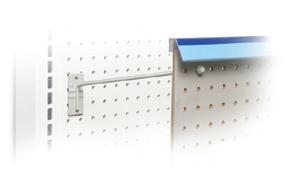

Extend your opportunities to increase revenue with Trion’s pegboard extenders. Use them to layer display surfaces so you can simultaneously show tall and short items. Commonly used to merchandise mops, brooms, long handled tools and more, with cross sells and accessories directly in front. Pegboard extenders extend your merchandising reach.
Extend your opportunities to increase revenue with Trion’s pegboard extenders. Use them to layer display surfaces so you can simultaneously show tall and short items. Commonly used to merchandise mops, brooms, long handled tools and more, with cross sells and accessories directly in front. Pegboard extenders extend your merchandising reach.
©2019 Trion Industries, Inc.
MERCHANDISIN G ®
HOOKS | lAbElING | SHElF & COOlER MERCHANDISING 800-444-4665 | info@triononline.com triononline.com/Art
THE ART OF
©2019 Trion Industries, Inc.
®
THE ART OF MERCHANDISIN G
HOOKS | lAbElING | SHElF & COOlER MERCHANDISING 800-444-4665 | info@triononline.com triononline.com/Art
©2019 Trion Industries, Inc.
Create Your Own Merchandising Masterpiece with Trion Fixtures HOOKS | lAbElING | SHElF & COOlER MERCHANDISING 800-444-4665 | info@triononline.com triononline.com/Art © 2023 Trion Industries, Inc.
HOOKS | lAbElING | SHElF & COOlER MERCHANDISING |
OF MERCHANDISIN G ® Create Your Own Merchandising Masterpiece with Trion Fixtures HOOKS | lAbElING | SHElF & COOlER Clean as a Whistle
OF MERCHANDISING ® Create Your Own Merchandising Masterpiece with Trion Fixtures
THE ART
THE ART
ART
THE AR T OF MERCHANDISINGTM
Merchandising is more than fito ut and fixtures It’s the art of creating an attractive, well-organized retail presentation. As with any artistic composition, a wide variety of tools may be used to create your masterpiece. In retail Visual Merchandising, a gondola, pegboard, slatwall or shelf is your blank canvas When combined with tools such as display hooks, label and sign holders, bar merchandisers, tray systems, and merchandising accessories, there are endless ways to effectively display all kinds of products and inspire your target audience to make a purchase. As one of the world’s top retail fixture manufacturers, Trion offers a generous supply of over 25,000 components and over 50 years of experience using them to execute precise planogram solutions, store designs and retail displays. Call us to turn your vision into an inspirational retail masterpiece.
DISPLAY AND SCAN HOOKS
LABEL HOLDER SYSTEMS
DIVIDER AND PUSHER SYSTEMS
BAR MERCHANDISING SYSTEMS
COOLER MERCHANDISING SYSTEMS
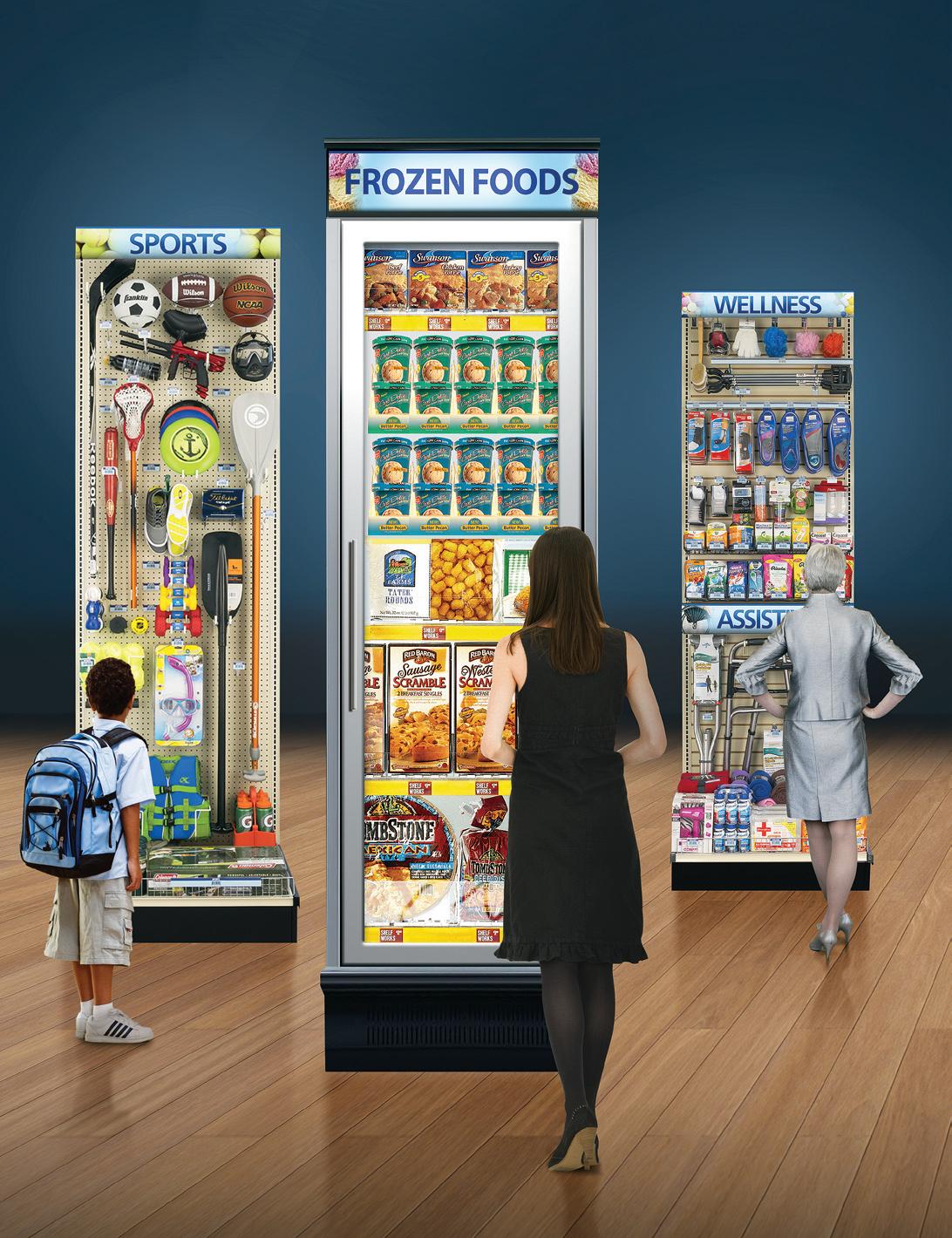
THE
OF MERCHANDISING ®
WWW.TRIONONLINE COM/ART | 800-444-4665 ©2015 Trion Industries, Inc.
Hooks | sH elf Merc H andising | l abeling WWW.T riononline co M/ ar T | 800-444-4665 ©2023 Trion Industries, Inc.
Pescanova Protein Pasta made from Wild Alaska Pollock

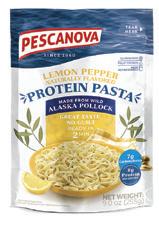

Suggested retail price:
















$4.99 per 9-ounce package


Made from responsibly caught, Marine Stewardship Council-certied wild Alaska pollock, Pescanova’s innovative product is currently the only pasta alternative made from seafood on the U.S. market. The gluten-free, low-carbohydrate pasta — which promises no shy taste — comes fully cooked, heats up in two minutes and contains only 70 calories per serving. It’s available in Garlic Basil, Lemon Pepper and Tomato Basil avors, and Pescanova is aiming to have 100% of its packaging be recyclable, reusable or compostable by 2025.
Planters Flavored Cashews

Suggested retail price: $3.99 per 5-ounce package Planters’ latest nut innovation promises larger-size cashews, a lightly coated texture and a selection of complementary avors, all offered at a competitive price point for everyday snacking. The avors —Dill Pickle, Cinnamon & Brown Sugar, and Rosemary & Sea Salt — were all carefully selected based on extensive consumer testing and research. To promote consumer awareness and drive retail sell-through, Planters implemented a comprehensive support strategy that included sampling programs, eye-catching displays, coupons, omnichannel programs and in uencer collaborations.
Pork King Good Old-Timey Butterscotch Pork Rinds

Suggested retail price: $3.99 per 3-ounce bag
Pork King Good has put a sweet spin on a traditionally savory snack with its Old-Timey Butterscotch Pork Rinds, which as well as being keto-friendly, gluten-free and low in carbohydrates, also promise a nostalgic butterscotch taste with a light and uffy, melt-in-your-mouth texture. The woman-owned company strategically launches all new avors online rst to its direct-to-consumer audience to test proof of concept, collect product reviews and determine demand for retail availability, and this creative avor checked all of the boxes.
collect avor checked all of the boxes.
Raised Gluten Free Cookie Mixes

Suggested retail price: $7.99 per 12-ounce package
Rob’s Backstage Popcorn Priyanka’s Mumbai Nights
$5.99 per 4-ounce bag
Actress Priyanka Chopra
Jonas lent her name and culinary heritage to this innovative variety from The Jonas Brothers’ Rob’s Backstage Popcorn brand. The blend of Indian-inspired avors used to avor the popcorn include turmeric, red bell pepper, carrot, onion, cumin and garlic powder, and the nished product is vegan, non-GMO and gluten-free. Rob’s launched Mumbai Nights in Walmart and Albertsons/Safeway stores nationwide, and the item is now the company’s top-performing avor extension.

Schnucks Cherry Cardinals Crunch Ice Cream
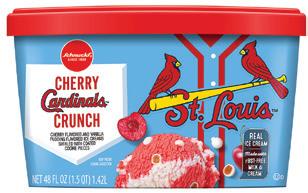
Suggested retail price: $4.49 per 48-ounce tub
This frozen dessert, a collaboration between Schnuck Markets and the St. Louis Cardinals baseball team, boasts packaging made to look like a Cardinals jersey and features coated graham pieces made to resemble baseballs. The limited-edition product launch was a major affair, with radio spots by current and former Cardinals players, samplings and autographs by alumni players and team mascot Fredbird, social contests for Schnucks rewards points, in-store signage, and even ice cream socials at the grocer’s corporate of ce.
Kid-friendly baking products are few and far between, but Raised Gluten Free took the concept a step further by making cookie mixes that also meet a slew of special dietary needs. The mixes, which come in Chocolate Chip, Double Chocolate and Confetti varieties, are 100% vegan, Certi ed Gluten Free and free of the nine top allergens, and the product line contains simple plant-based ingredients like rice our, cane sugar, sea salt and naturally colored sprinkles. The illustrated step-by-step instructions are easy to follow, and the colorful packaging makes the mixes stand out on the shelf.
Suggested retail price: $5.99 per 5.1-ounce cup
Scout is on a mission to expand the audience for seafood by making it more delicious, more convenient and more responsibly sourced. The company’s Seafood Snacks bring convenience and accessibility to premium sustainable seafood, with each variety pairing responsibly sourced yellow n tuna in olive oil with a crunchy topper that’s inspired by the trending international taste pro les of Chili Crisp, Chile Jalapeño and Za’atar. Each package comes complete with a paperboard mixing bowl, and the entire kit is plastic-free and fully compostable or recyclable.

PROGRESSIVE GROCER September 2023 29
SE Grocers Party Cubes

$3.99 per 10-pound package
What’s so innovative about ice, you ask? Southeastern Grocers partnered with Relocalize to introduce Party Cubes, which are manufactured in the world’s rst autonomous micro-factory and designed to help eliminate middle-mile logistics to reduce global greenhouse-gas emissions, water waste and plastic pollution. Not only is the super-premium cubed ice made ef ciently, locally and on-demand for select stores, but it also offers easier storage and an environmentally conscious and affordable alternative to standard ice products. We hope that answered your question.
SeedWise Soft Baked Grain Free Cookies
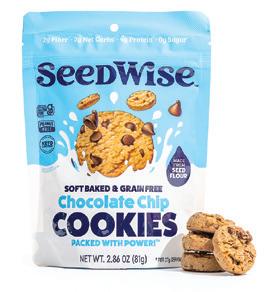
Suggested retail price range:
$4.99-$5.99 per 2.86-ounce package
These soft-baked, grain-free cookies from SeedWise are free from the top nine food allergens; crafted with a proprietary blend of seed our consisting of pumpkin seeds, sun ower seeds and ax seeds; and packed with nutrients. The unique ingredient list underscores the fact that growing seeds requires 20 to 90 times less water than tree nuts, making these cookies an environmentally conscious choice. The company’s internal analysis has proved that, compared with other better-for-you cookies in the same category, its cookies boast superior nutritional pro les while offering a competitive price per package.
Ser!ous Bean Co. Hot Honey Baked Beans

$1.99 per 15.5-ounce can
Owned and made by Lakeside Foods, Hot Honey Baked Beans from Ser!ous Bean Co. are avored with real honey and smoked bacon. Taking advantage of two seriously popular avors, the company takes the cake for being the rst hot-honey item in its category. Ser!ous Bean Co. is hoping to generate incremental sales in the category through such methods as organic social media, e-mail communication, dynamic online product listings with retailers, ratings and reviews, and direct-to-consumer availability.
Simply Done Glass Food Storage Containers
Suggested retail price range:
$3.99-$10.99 for various sizes
Topco’s environmentally friendly glass storage containers can be used for dry storage, refrigerating or freezing leftovers, reheating in the oven or microwave, and many other kitchen needs. Each container comes with a leakproof snap-on lid that holds in freshness and prevents accidental spillage and freezer burn. With five size options, Topco’s containers fill a private label product void while also meeting the needs of eco-focused shoppers.

SimplyV Plant-based Cream Cheese

Suggested retail price: $5.99 per 8-ounce container
SimplyV’s alternative cream cheese is non-GMO and dairy-, gluten- and lactose-free, as well as containing no arti cial preservatives, soy or palm oil. The product, which was developed by a small team of artisan cheesemakers with many years of combined plant-based experience, comes in Original, Strawberry, and Onion & Chive varieties and gets its traditional cream cheese avor and texture from the inclusion of almonds. Additionally, SimplyV is the rst company to offer plant-based cream cheese in a baking-bar format.
Smartwater Alkaline with Antioxidant

Suggested retail price: $2.19 per 20-ounce bottle
The latest hydration innovation from The Coca-Cola Co.owned Smartwater caters to increasing consumer demand for functional beverages. A 9.5 pH level and the addition of selenium help complement active, high-performance lifestyles while also boosting Smartwater’s presence in the alkaline water category. Looking forward, Smartwater plans to expand the sports-cap feature of the water to allow for wider availability and convenience for consumers, and also position it as a hero product at the 2024 Olympic Games to enhance global visibility, brand recognition and sales.
So Good So You Metabolism
Citrus Cinnamon Probiotic Shot

$3.99 per 1.7-ounce bottle
So Good So You launched this product as the rst shot in the cooler focused on metabolic health, to meet a need indenti ed by consumers in the category. The metabolism shot offers ve thermogenics: organic ginger juice, organic turmeric juice, organic green tea extract, organic cinnamon and organic cayenne. All of the company’s products are made in a 100% renewable energy-powered, zero-waste manufacturing facility, which diverts more than 94% of its waste from land lls.
30 progressivegrocer.com








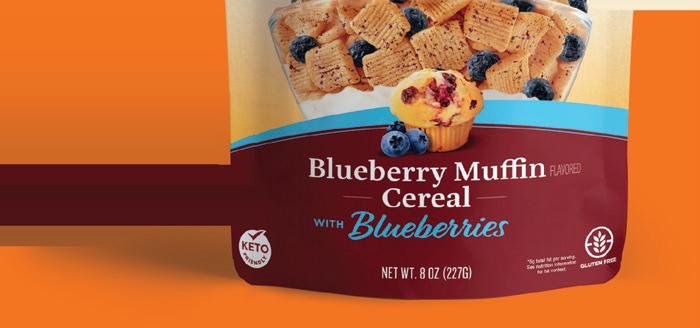

















NEW! SCAN HERE FOR MORE PRODUCT DETAIILS! KETO FRIENDLY LOW SUGAR GLUTEN FREE HIGH PROTEIN THE CEREAL YOU CRAVE Now Paired with the Toppings You Love Introducing
Soleil Sparkling Water-Yuzu Citrus

Suggested retail price:
$2.99 per 8-pack of 12-fl uid-ounce cans With no other yuzu- avored sparkling water on the shelves at Albertsons Cos. stores, the company is meeting consumer demand based on the growing popularity of on-trend, emerging avors. The item was added to several in-store promotional events and featured on the company’s internal website to help get customers excited about the new avor and understand what yuzu tastes like. The packaging boasts teal and yellow colorways to stand out from similar items on the shelf.
Sweet P’s Churro Donut Bites
Suggested retail price:
$3.99 per 12-ounce package
A unique product for the perennially popular doughnut category, Topco’s Churro Donut Bites are made in a nut-free facility and offer a fun bite-sized snack. Smaller-format sweet goods continue to grow in popularity year over year, with new offerings like these helping to drive those sales increases. According to Topco, prominent in-store displays are often all that’s needed to quickly move these tiny doughnuts from shelf to table, but the product is also supported by in-store, in-aisle and online marketing tools.
Think! Sweet Treat High Protein Bar-Boston Crème Pie
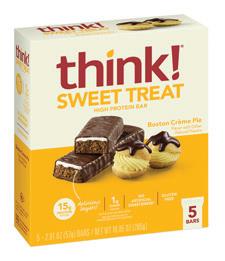
Suggested retail price:
$9.99 per 10.05-ounce 5-count box
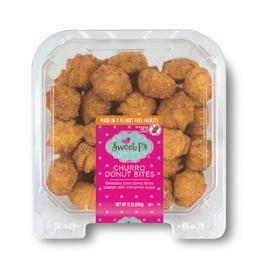
Thanks to dual-layer technology, this Boston Crème Pie- avored bar from Think! lets consumers treat themselves to a decadent crème layer while taking in 15 grams of protein and 4 grams of ber. Best of all, each gluten-free bar contains only 1 gram of sugar and no arti cial sweeteners. Think! is known for its mission to make a positive impact on people, communities and the planet, and the company continues to build on its public relations, shopper marketing and in uencer efforts.
Thrive Market/LesserEvil All About the Elote Organic Popcorn
Suggested retail price:


$2.24 per 4.6-ounce bag
This Thrive Market exclusive, created with LesserEvil, elevates traditional popcorn by using elote, a grilled corn avor that features peppers, cheeses and spices. The product is being cross-promoted by both brands, and so far it has contributed to 25% of total company revenue tied to Thrive Market’s private label business, according to the e-grocer. In a nod to the environment, the new collection’s packaging is from NEO Plastics, maker of an organic additive that transforms traditional plastic packaging into a sustainable solution made for disposal in land lls.

TopCare Black Elderberry Syrup

Suggested retail price: $7.99 per 4-fl uid-ounce bottle
Consumers can now support their immune systems without emptying their wallets, thanks to this more affordable supplement. TopCare Black Elderberry Syrup is naturally avored and sugar- and gluten-free. Liquid vitamins are one of the fastest-growing vitamin segments, according to Topco, which reports that the leading national brand’s black elderberry liquid vitamins have experienced a 33% increase in dollar sales recently. Despite this popularity, the segment has been underdeveloped in the own-brand arena. This item gives Topco members a perfect way to break into the category, especially as demand is expected to grow exponentially. Topco is supporting the product with in-store and online marketing tools.
TopCare Foaming Bath Made with Pure Epsom Salt

Suggested retail price: $3.99 per 34-fl uid-ounce bottle
Stressed-out shoppers will appreciate Topco’s value-priced TopCare Foaming Bath Made with Pure Epsom Salt, which comes in two popular scents: relaxing Lavender and invigorating Eucalyptus & Spearmint. Packaged in a blue plastic bottle reminiscent of glass apothecary jars, the bath product brings to mind simpler times and natural remedies. The line is free from parabens, phthalates and formaldehyde donors, and is being supported by in-store and online marketing tools. Repurchase intent for Foaming Bath continues to be highly positive, according to Topco.
TopCare Verisol Collagen
Suggested retail price: $9.99 per 90-tablet bottle
Formulated to support hair, skin, nails, joints and bones, TopCare Verisol Collagen contains 60 milligrams of vitamin C for optimized collagen synthesis, according to Topco. Similar to leading brands but with a more affordable price tag, the dietary supplement comes in an easy-to-swallow caplet. The collagen segment is poised to grow 69% in the coming years, Topco notes, so retailers should consider adding this item not only to increase their own-brand sales, but also to have a sustained presence in the category for years to come. Topco is supporting the product with in-store and online marketing tools.


32 progressivegrocer.com
Vinaforé Alexander Valley Cabernet Sauvignon


Suggested retail price: $21.99 per 25-fl uid-ounce bottle
Within the rst six months of its launch, Albertsons’ Vinaforé Alexander Valley Cabernet Sauvignon has been one of its most successful private label wine launches ever. In fact, the product has begun to amass a following, and Albertsons is looking to drive even more engagement by using an online landing page and including the wine in its playbook for focus items during peak buying seasons. In contrast to most national brands, the front label of the wine features a wealth of information, including its age (complete with barrel type and length of time), tasting notes, varietal composition and vineyard in uence, as well as a master-of-wine signature of approval.
Watkins 1868 Organic Grilling Salt-Free Steak Seasoning

Suggested retail price: $4.99 per 2.6-ounce bottle
Consumers who need to watch their sodium intake will appreciate this avorful organic steak seasoning from The Watkins Co. The Watkins 1868 Organic Grilling line has quickly become the No. 3 organic grilling brand in the category, according to the company, and Salt-Free Steak Seasoning offers a special blend designed to enhance steak’s natural avor. The product is also Non-GMO Project
Veri ed and kosher. Watkins supported the launch through an integrated mix of traditional and digital marketing and retailer-speci c activations to drive sell-through at both brick-and-mortar and online retailers.
Watkins Organic Pumpkin Pie Spice

Vital Farms Restorative Eggs
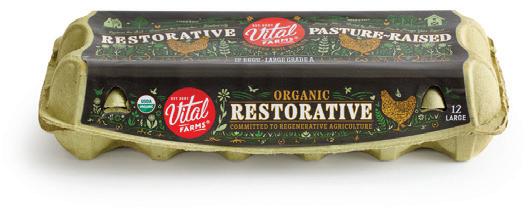
Suggested retail price: $9.99 per 12-egg 24-ounce carton
Available exclusively at Whole Foods Market locations, Vital Farms
Restorative Eggs take agricultural standards to the next level. These eggs are produced on a core group of regenerative farms employing a comprehensive suite of regenerative agriculture practices and advised by experts. Meanwhile, consumers can go to Vital Farms’ website and type in the name of the farm printed on the side of the egg carton to view a 360-degree video about the farm and its hens. Vital Farms has supported the product with media events, coupon mailings and a social media program, and the company is looking to expand to other natural retailers in the near future.
Wahlburgers Drumstick Lollipops

Suggested retail price: $11.99 per 48-ounce bag Move over chicken wings — Wahlburgers’ ready-to-cook Chicken Drumstick Lollipops are the latest sensation in handheld poultry products. The company has patented the item and envisions applications for it in both the frozen case (as it’s currently sold) and the full-service deli. The lollipop makes use of the chicken drumstick — an item that traditionally has had little demand and excess supply — yet processes it in a way that is more appealing than traditional drumsticks. Wahlburgers is cross-promoting Drumstick Lollipops with the rest of its popular portfolio of sauces and burgers, and is heavily relying on social media promotion and in uencer marketing to reach out to more consumers.
Suggested retail price: $6.99 per 2.6-ounce bottle With peak pumpkin spice season fast approaching, retailers should consider stocking this better-for-you seasoning to expand options for their customers.
Watkins Organic Pumpkin Pie Spice stands out because it’s kosher, Non-GMO Project Verified and certified organic by QAI, as well as containing no dyes, high-fructose corn syrup or MSG. The spice is ideal for pies, bread, cookies, pancakes or even beverages. It has been supported through an integrated mix of traditional and digital marketing and retailer-specific activations.
Wild Harvest Almond Cranberry Rice Clusters

Suggested retail price range: $3.99-$5.99 per 3-ounce package
Wild Harvest Almond Cranberry Rice Clusters is one of the newest additions to a growing line of better-for-you options from United Natural Foods Inc. (UNFI) These rice clusters are made with sweetened dried cranberries, pink Himalayan salt, puffed rice and dry-roasted almonds. They’re also gluten-free and certi ed nonGMO, and made without arti cial colors, preservatives or avors. UNFI supported the launch with tailored outreach to trade and consumer media outlets, as well as with social media. The company hopes to expand the product’s retail presence in the near future.
PROGRESSIVE GROCER September 2023 33
Wildwonder Pineapple Paradise Prebiotic + Probiotic Sparkling Drink

Suggested retail price: $3.49 per 12-fl uid-ounce can
Combining a grandmother’s wisdom and the freshness of a California fruit stand, Pineapple Paradise
Prebiotic + Probiotic Sparkling Drink is Wildwonder’s latest beverage to feature both live probiotics and prebiotic ber. The refreshing drink, packaged in a slim, colorful can, was inspired by the Chinese healing tonics that founder Rosa Li’s grandmother brewed for her as a child. It features a mix of pineapple and tangerine juices, Szechuan peppercorn, and cinnamon. Sweetened with monk fruit, the beverage contains only 6 grams of sugar and 35 calories per serving. The company is promoting it through digital marketing, earned media and VIP giftings. Following an exclusive distribution with Sprouts Farmers Market, Wildwonder plans to roll the beverage out to additional retail accounts.

Woodstock Red Lentil and Eggplant Ravioli
Suggested retail price: $10.99 per 20-ounce package
Woodstock Red Lentil and Eggplant Ravioli gives consumers a simple yet healthy vegan meal solution that contains premium restaurant-quality ingredients. Produced in Italy, the ravioli is USDA Certi ed Organic and stuffed with a hearty roasted eggplant lling. Unlike many other frozen pastas in the category, this ravioli is made with no arti cial colors or avors. United Natural Foods Inc. supported the product’s launch with tailored outreach to trade and consumer media outlets, as well as with social media ads and in uencer activations. The company plans to continue building its Woodstock frozen pasta line by expanding its retail presence and launching new products where applicable.

Zapp’s SinfullySeasoned Pretzel Stix


Suggested retail price: $5.48 per 16-ounce bag
Voodoo and Jazzy Honey Mustard bring the bold avors of New Orleans to a classic pretzel stick form. This snack from Zapp’s —previously known for its chips — was launched earlier this year with a second-line parade in New Orleans’ famous French Quarter neighborhood, followed by a social media giveaway. The Sinfully-Seasoned Pretzel Stix have resulted in a positive impact not only on the Zapp’s brand, but also on the category as a whole, with avored pretzels up 24% versus a year ago, according to parent company Utz Brands Inc. Look for more avors soon.
34 progressivegrocer.com
Yasso Vanilla Bean Poppables

Suggested retail price:$6.49 per 6.84-fl uid-ounce package
Coinciding with a packaging redesign and a reduced product size, Poppables has added Vanilla Bean Poppables to its indulgent snacking lineup. These small snacks with big avor feature bite-sized frozen Greek yogurt covered in a crunchy dark chocolatey shell. At just 35 calories per Poppable and with no arti cial ingredients, consumers will feel tempted to snack on them by the handful. Also, thanks to the new resealable bags and a slightly smaller product size, consumers now have 50% more food to snack on. Yasso created unique ad spots that ran across broadcast TV and streaming and digital platforms. The company also invested in customer marketing tactics at key retailer accounts and made use of social media and in uencers.
Zoup! Good, Really Good Soups
Suggested retail price: $5.99 per 16-ounce jar






Just in time for the start of autumn, Zoup! Good, Really Good Soups provide heat-and-eat varieties that are complex yet comforting, inspired yet familiar. For example, Chicken and Riced Cauli ower Soup combines a savory chicken broth with classic herbs and spices, a traditional mirepoix, white meat, and low-carb riced cauli ower. Meanwhile, the company’s Spicy Chicken ‘Chilada Soup brings together a zesty mix of tomatoes, roasted corn, black beans, onion and chili pepper. Each of Zoup!’s ve soups features high-quality ingredients with no arti cial ingredients, preservatives or GMOs. The Zoup! brand got its start in the restaurant industry, and the company has built on its experience with a PR campaign, podcast advertising, in uencer partnerships and retail promotions.
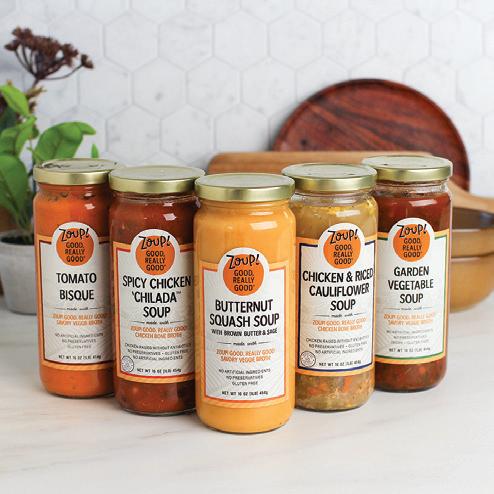
CURATED
NO RESERVATIONS NEEDED www.carbonefinefood.com|
BY AWARD-WINNING CHEFS | MADE FROM 1 % ITALIAN TOMATOES SLOW-COOKED IN SMALL BATCHES | NO SUGAR ADDED
Unbreakable BONDS
By Gina Acosta
When it comes to the future of the grocery industry, there’s no shortage of advice.


Some experts say that grocers looking to thrive in the omnichannel age should focus on reimagining their physical formats and experimenting with technologies such as generative AI and micro fulfillment. Others say that retailers should prioritize automation, sustainability goals and retail media.
Many retailers are doing most or all of that, but only a handful of them have been doing it for a century — and even fewer have been able to do it while preserving the bonds of a strong company and customer culture. One of those grocers is The Giant Co., which celebrates its 100th birthday on Oct. 4.

From its humble beginnings in 1923 as a butcher shop in Carlisle, Pa., called Carlisle Meat Market, to a 193-store operator with an army of 35,000 team members serving customers across Pennsylvania, Maryland, Virginia, West Virginia and New Jersey, the grocery chain known as The Giant Co. is just “an amazing brand,” according to President John Ruane, a lifelong veteran of the grocery business who took over officially as president in July after serving as interim chief for nearly a year.

“Some of the things that make The Giant Co. brand special include our heritage of being a place that has driven value. Value is a combination of price, quality, variety and service. Some of the things that we think about often are: How do we find ways to drive value for customers? What are the items that they need the most? How do we price them most aggressively? How do we deliver those things that really build meals for their families? Connecting families around the table is the foundation of our brand.”
The Giant Co., which encompasses the Giant, Martin’s, Giant Heirloom Market, Giant Direct and Martin’s Di-
From its humble beginnings in 1923 as a two-man butcher shop in Carlisle, Pa., called Carlisle Meat Market, to a 193-store operator with an army of 35,000 team members serving customers across Pennsylvania, Maryland, Virginia, West Virginia and New Jersey, the grocery chain known as The Giant Co. is just “an amazing brand,” according to President John Ruane, a lifelong veteran of the grocery business who took over officially as president in July after serving as interim chief for nearly a year.

36 progressivegrocer.com RETAILER DEEP DIVE
The Giant Co.
The Giant Co. celebrates 100 years of connecting families for a better future.
rect banners, is owned by parent company Ahold Delhaize USA, a division of Zaandam, Netherlands-based Ahold Delhaize (which had annual revenue of $92 billion in 2022). In May, Ahold Delhaize, which operates more than 2,000 grocery stores in the United States, reported strong earnings for its second quarter and attributed a 2.7% growth rate in U.S. comparable sales in part to the strength of sales at The Giant Co.
“We are proud of the entire team at The Giant Co. for reaching a historic milestone of feeding families and serving local communities for 100 years,” said J.J. Fleeman, CEO of Ahold Delhaize USA, at the tine. “Few retailers – and even fewer grocers –have stood this test of time. As The Giant Co. steps into its next century of service, we are grateful for the 35,000 team members who serve customers every day, and we’re humbled by the thousands of customers who choose Giant to help nourish their families. In celebration of the entire Giant Co. family, here’s to 100-plus more years!”
Connecting Customers
Over the past 100 years, The Giant Co. has certainly evolved its business model and go-to-market strategy, but its most recent transformation might have been its most prescient.
In February 2020, the company changed its name from Giant Food Stores to The Giant Co. as it looked to distinguish itself from sister banner Giant Food, based in Landover, Md. (both chains are operated by Ahold Delhaize USA). A few months later, The Giant Co. rolled out a new brand platform: For Today’s Table. Building on the new company name, For Today’s Table mapped out a course for the business’ growth and its connections with customers.
It’s been a tough few years for the grocery industry since 2020, but “as much as the business has changed,” Ruane notes, “the core elements are still the same in terms of customers want what they want, when they want it, and they have a lot of options to go get it. We’re in a really challenging economy, and they have a lot of choices, so we want them to choose us, but we know we have to earn the right for them to choose us, and that’s where we continue to focus on giving the customer a consistently friendly, fresh, great experience every time they shop.”
Ruane, who started out in the grocery industry at age 14 in New Jersey and led The Giant Co.’s

PROGRESSIVE GROCER September 2023 37
“We’re in a really challenging economy, and [shoppers] have a lot of choices, so we want them to choose us, but we know we have to earn the right for them to choose us, and that’s where we continue to focus on giving the customer a consistently friendly, fresh, great experience every time they shop.”
—John Ruane, President, The Giant Co.
RETAILER DEEP DIVE The Giant Co.
merchandising and marketing teams before being promoted to president, says that the company is leaning in harder on capturing occasions as competition heats up in the retailer’s crowded trading area. “There’s actually more value discounters in our trading area than any other trading area, at least in the world of Ahold Delhaize on the East Coast,” he observes. “We have over 800 value competitors, so it’s super-competitive. We see a lot of cross-shopping. I think everybody is just fighting for the units today, because as we’ve seen inflation ramp up, they’re not buying as many units as they used to.” However, he points out, some of those inflationary trends are starting to ease.
“We’re actually seeing deflation in some areas like fresh, which we’re happy about,” Ruane notes, but “we need to do better and find different ways to not only find the right products, but also price them right and display them correctly.”
Connecting Occasions
Luckily for The Giant Co., it had started down an omnichannel path way before there was even a whiff of a pandemic. The Giant Co. has been accelerating its e-commerce operations since at least 2019, when it opened its first e-commerce hub, in Lancaster, Pa. The company has several e-commerce fulfillment centers and hundreds of delivery and pickup locations, with shoppers across 90% of its market area having access to online grocery and delivery services.

value items so that we have competitive pricing on those, and many of those are actually private-brand items, too,” Crishock says, going on to note that the retailer has expanded its Global Flavors private-brand assortment and incentivized shoppers to choose own-brand products labeled with its proprietary nutritional rating system, Guiding Stars.
“Even despite inflation, despite the supply chain disruptions, we’ve continued to see our customer service metrics, as well as cashier friendliness, improve year over year,” Crishock observes. “We are hyper-focused on customer experience. We have a customer experience tracker that we review on a weekly basis, so it’s something that is always top of mind and top of discussion in terms of how we are performing. It’s very encouraging to see those metrics continue to improve, or at least be steady, despite disruptions that customers are feeling in the market.”
The company is leveraging data to learn more about why its shoppers choose it as a primary destination. “It’s all about the data we can personalize,” Ruane asserts. “We do a lot of it now, but we need to do more of it in the future: getting to know the customer, the communities we serve, being able to build a plan that we can scale, but also at the same time we can localize. And we’ve done a lot of good work around localization.”
Being able to offer convenience in a variety of formats, especially now, is key, according Joanna Crishock, VP of marketing and commercial planning at The Giant Co.

“Another way that we’ve done that is just by the expansion of our relationship with Instacart, as well as our owned channel, Giant Direct delivery, as well as pickup options,” Crishock adds. “We made those even easier to access earlier this year, when we relaunched our app. So, [we offer a] refreshed app, [an] easier experience, less clicks to get to what you want, better ability to personalize and pull out the rewards and savings that we’re … giving to customers from shopping with us and from being digitally engaged.”
The company has also extended its famous Bonus Buys, allowing shoppers the opportunity to take advantage of these deals over the course of four to six weeks, instead of just one week, so that they’ll be able to stretch their budgets — guaranteed.
“We have made price investments in some of our key
Over the past five years, The Giant Co. has more than doubled the number of its local suppliers to be able to give customers the brands that are important to them.
In addition to whetting shopper appetites for local products, the grocer has expanded its private-brand assortment, pushed into new merchandise categories, and opened several new formats such as its Heirloom Market concept, a combination of modern design, hyper-localization and globally inspired foodservice. In fact, when the pandemic eased, The Giant Co. was one of the first retailers to reopen its foodservice bars.
Speaking of which, how has retail foodservice fared post-pandemic? “What we actually saw is it didn’t fully come back right away, and in some cases, it’s still not fully back to where it was,”
38 progressivegrocer.com
“Even despite inflation, despite the supply chain disruptions, we’ve continued to see our customer service metrics, as well as cashier friendliness, improve year over year.”
—Joanna Crishock, VP of Marketing and Commercial Planning, The Giant Co.
The Giant Co. has been accelerating its e-commerce operations since at least 2019, when it opened its first e-commerce hub, in Lancaster, Pa. The company has several e-commerce fulfillment centers and hundreds of delivery and pickup locations.


















Instant Power Corporation • 800-613-4242 • Sales@myinstantpower.com • Heavy Duty Drain Opener • Hair Clog Remover • Crystal Lye Drain Opener The WWW.MYINSTANTPOWER.COM Seriously strong solutions to tackle tough cleaning tasks. • Disposal and Drain Cleaner • Dishwasher Cleaner • Disposal & Drain Cleaner in the home improvement category ... now available for grocery retailers nationwide! Drive growth and margins with Instant Power products. Scan to learn more. Available now for shipment
The Giant Co.

Ruane admits, “but I think what it does is it helps us rationalize the business better, and at the same time, we’ve seen an increase in some of our chilled prepackaged offerings, prepackaged salads, sandwiches and meals. Those things have actually elevated.”
The next evolution of the retailer’s operational strategy is leveraging the scale of its Ahold Delhaize partners, Retail Business Services and Peapod Digital Labs, to streamline or improve processes with regard to retail media, e-commerce, shrink, team experience, supply chain, merchandising, IT and new stores. Regarding this last item, The Giant Co. plans to open two new stores in Pennsylvania in 2024-25, and Ruane says that he’s working on remodeling older stores.
“We had some stores that hadn’t been touched in years,” he notes, “so we’re doing our For Today’s Table format refresh and some upgrades in refrigeration as we march toward the Ahold Delhaize Net Zero 2040 goal.”
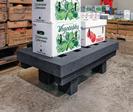
Connecting Core Values
When it comes to The Giant Co.’s approach to environmental, social and governance (ESG) work, the retailer is guided by its purpose, whether that means taking steps to heal the planet, eliminate hunger, change children’s lives, or promote well-being in the communities it serves. That purpose also
BEST IMPRESSIONS
involves weaving what it calls “a red thread” of authenticity into its employee value proposition, which team members find hard to resist. “Care and teamwork are two of our values that I’m just going to say are a really strong red thread through everything that we do as a company and that we experience,” affirms Jennifer Heinzen Krueger, VP of team experience at Giant Co. “When we ask our team members, ‘Why have you stayed 40 years or 55 years?’ it’s always a story of, ‘I love working with my colleagues, my team members, the people here, what make us so different, my manager treats me with respect, or I just love the customers that I work with every day.’ That’s really how I would describe our culture, really anchored in that care and that teamwork.”
Since the pandemic, the industry has been challenged with finding people to fill some jobs, so Krueger characterizes her focus as becoming more flexible with hiring, training and how work gets done. The retailer also encourages its team members to take part in volunteerism.





“How do we make jobs more interesting for those who are maybe in a group that are not as aggressively sought after by employers?” Krueger muses. “I think that’s maybe where some of the magic comes in. We’ve done a lot in this space with younger teens, neurodiversity, internships, just really looking to unlock career paths.”
The company is also trying to reinvigorate what it does in the area of retention by focusing on cross-training, growth opportunities, and helping team members really see that “if the job they are doing right now has gotten boring, there’s so much more that you can do, and we are going to help you get there,” Krueger asserts.
At the end of the day, Crishock says, the core values at the center of The Giant Co. are the same as those shared across Ahold Delhaize.
“We all share the same core values of teamwork, care, courage and integrity, as well as humor,” she points out, “and those are essential to who we are as an overall brand and the foundation of that.”
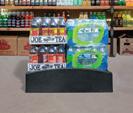
40 progressivegrocer.com RETAILER DEEP DIVE
“Care and teamwork are two of our values that I’m just going to say are a really strong red thread through everything that we do as a company and that we experience.”
Stop by NACS Booth #BC6323 | Atlanta | Oct 4–6 365330 masonways.com • newpig.com
—Jennifer Heinzen Krueger, VP of Team Experience, The Giant Co.
FROM FLOORS TO FORECOURTS AND MORE
DUNNAGE RACKS DISPLAYS & MERCHANDISERS FORECOURTS & FUEL ISLANDS FLOOR SAFETY

www.enstrom.com

IT IS THE GROCERY CHANNEL’S TURN TO SPARK SALES WITH GESTURETEK

GestureTek is a trailblazer in bringing interactive display technology to major companies around the globe, from Target and Gap to Procter & Gamble and Kraft Foods. Its engaging interactive wall and floor advertising displays produce validated positive results across hundreds of industries.
Now is the grocery sector’s time, said GestureTek CEO and co-founder Vincent John Vincent in an interview with Progressive Grocer.
Tell us about GestureTek and its track record across myriad industries.

Vincent John Vincent: GestureTek is the name given to a process by which consumers effortlessly interact with audio-visual displays through hand and body movements (“gestures”). Consumers can do this deliberately, or the system can do it automatically, to capture the consumer’s attention. For example, GestureTek’s visual projections on floors, or walls or screens react to consumers simply passing by.
The GestureTek unit creates a unique series of experiences for consumers through visual projections, typically beamed from the ceiling. We invented this and were awarded over 60 patents over the years. We have created thousands of installations in diverse public settings like theme parks, museums, airports, malls, hospitals, non-grocery retailers and even for NASA.
GestureTek is now looking at pilot project opportunities in the grocery sector specifically. We see so much opportunity wasted in grocery stores because of all the unused
floor space. To us, that floor space is a huge, beautiful canvas!
We can design fabulous next generation consumer engagement for our brand partners, and we can help grocery stores boost their revenue at the same time. Even in GestureTek’s early days, Nielsen/Arbitron determined that use of our system generated positive behavior by consumers. We have always known that GestureTek raises the bar in consumer engagement.
How do you see the grocery industry benefitting from your technology?
VJV: We have a revenue sharing model for the grocery stores. For the retailer, it’s pure profit. Grocers receive money on a recurring basis that they did not have before. GestureTek pays all the costs of installation and maintenance of our systems, and GestureTek shares with the store a fee that consumer product brands pay to use the service. Also, grocery stores benefit from other information uses that GestureTek can be applied toward, such as reminding shoppers of specials or other messages. GestureTek adds a modern
“cool factor” to the store setting. Consumers today are seeking “experiences” that make them want to return to that destination. The public has become accustomed to the concept of “interacting” with digital hardware/software and things continue moving in this direction.
Grocery stores have been missing a positive opportunity in this regard. GestureTek can help with that.
How can retailers and brands get involved with GestureTek?
VJV: Easy—drop me an e-mail at Vincent@GestureTek.com or call (416) 340-9290, Ext. 1001. My colleagues and I will start to fill you in regarding options that could be tested in appropriate settings. Contact is equally welcome from both the grocery sector and consumer product companies. The creative opportunities are endless. We don’t run out of ideas at GestureTek.
GestureTek can be as helpful to small brands who need to boost consumer attention as GestureTek is useful to top brands who want to sustain their primacy. Literally everyone wins with the arrival of GestureTek in supermarkets. The grocery stores see more revenue. The product brands get an additional marketing opportunity in the coveted “in-store” environment, where last minute impulse buying is viable. Even consumers get a shopping experience worth returning for. It’s a winning concept, all around.
ADVERTORIAL
FOR MORE INFORMATION CONTACT: Vincent@GestureTek.com
Laying the Operational Foundation for Autonomous Stores

RETAILERS MUST KEEP PACE WITH ADVANCING TECHNOLOGY — AND THE COMPETITION.
By Michael Gabay
hile autonomous stores and technological innovation are high on the retail agenda, the infrastructure and operational efforts that enable them aren’t often given the same broad attention. However, as more retailers look to embrace the benefits of embedding digital solutions into their physical stores, it is becoming clear that developing internal processes and infrastructure for the deployment of new technologies will determine which companies thrive in today’s rapidly changing retail environment.
According to Deloitte, technological preparedness is one of the deciding factors for companies that fare well through tumultuous economic periods such as the COVID-19 pandemic. But the value of laying a robust foundation for technological adoption extends beyond times of crisis. Companies must excel and stay ahead of the curve in today’s technologically competitive environment.
Preparing Internal Operations for Smart Stores
The importance of operational preparedness is especially true for grocers implementing emerging technologies such as autonomous checkout, also referred to as seamless checkout. Grocery retail is rooted in a traditional brick-and-mortar business model, with many long-standing and comprehensive internal processes. These operations may struggle to adapt to the unique needs of automated checkout systems and smart stores.
One of the biggest operational changes that grocery retailers will face is employee training and role reassignment. With the adoption of autonomous store technologies, employees will shift into customer service and technical roles. Grocery retailers must create specialized training programs for new roles and responsibilities. Developing such programs can take several months, depending on the size and resources of the retailer’s learning and development teams.
In “Transforming Operations Management for a Digital World,” McKinsey & Co. discusses a bank’s investment in digitization and the operational changes required to succeed. The report explains that “building the portal wasn’t enough, nor was training branch associates to show customers how to use it. The whole bank needed to reorient its activities to showcase and sustain digital. That meant modifying roles for everyone, from tellers to investment advisers, with new communications to anticipate people’s concerns during the transition and explain how customer service was evolving.”
Similar to the grocery retail industry, banking is a traditional industry rooted in brick-andmortar practices. Both banking and traditional retail are being disrupted by digital-native services, whether they’re online banking and neo-banks or online grocery delivery and meal kit subscription programs. Both must adopt cutting-edge technologies that automate and digitize their services to evolve — and survive — in their business category. Grocery retailers are realizing that implementing frictionless checkout tech is not a one-and-done process. Operational adjustments to the workforce, training programs and internal processes are needed to set up for success.
Turning Insights Into Action
The first step is to establish an internal task force comprising technology, business,
44 progressivegrocer.com GUEST VIEWPOINT Store of the Future
Since the inception of the the autonomous store in 2018, dozens have been deployed around the world, including this Trigo-powered REWE store in Berlin (Image courtesy of REWE Group)
finance and operations representatives. The task force should be given the resources and authority to determine the measures necessary for the implementation of automated checkout systems. The task force should then explore different technologies, providers and partners, as well as look at similar businesses to see which steps they took and how they chose to innovate. Following this stage, the task force should come together internally and draft recommendations based on its expertise and findings. This will include proposing changes and recommending budgets and timelines that will prepare the organization to move forward with autonomous retail.
Infrastructure Changes Are Inevitable — and Are Already Happening
Flexible infrastructure is an innovation enabler. Certain technology vendors know how to transform even stores with the most outdated infrastructure, but it’s important to set expectations accordingly — the more flexible the infrastructure, the smoother the transition will be. It’s similar to upgrading your smartphone: At some point, even though your old phone still works, you may realize you need more battery life and processing power to support more and more sophisticated apps.
Traditional grocery stores are still highly operational, and many customers are attached to the traditional grocery experience. But when other players are updating their stores left and right, enabling them to offer superior and more diverse shopper experiences, a traditional store may become outdated quickly.
Retailers that act now to put in place the infrastructure that supports technology that can turn their existing stores into smart ones will have the upper hand and keep their stores up to date. This transformation is already familiar to most retailers from other parts of the supply chain. For example, grocery retailers have made infrastructure changes in their warehouses and micro-fulfilment centers by upgrading network connectivity in these facilities. This change is necessary to provide the real-time data that powers the robots and automation tools that are central to retailers’ inventory management.
The frictionless checkout experience delivered by an autonomous grocery store can be perceived by customers as magical, and the technology behind it is groundbreaking, but like any other technological innovation, it requires tangible infrastructure in place so it can work its magic.
Keeping Ahead of the Learning Curve
The process of implementing autonomous stores is similar to preparing for and running a marathon: You need to prepare both physically and mentally to run the full distance. Similarly, the successful deployment of frictionless checkout in stores requires both physical adaptations and a mindset shift within the organization. Expect it to be a learning curve. Each retailer’s unique brand personality also brings a new set of challenges for the technology, such as different product lines, use cases, and shopper behaviors and expectations. Some retailers have come to realize that they must begin preparing the ground for frictionless checkout tech even before they open their first store.
This learning process is a critical part of successful implementation and scale. Some retailers choose a more passive approach, opting to wait and see how other players implement emerging technologies, hoping to learn from their successes and mistakes.
They’re running the risk of falling far behind their competition. More than that, however, they’re running the risk of learning the wrong lessons. Each organization is unique, with its own needs and expectations. One retailer can attempt to mimic the actions of another, with a completely different outcome. Such a retailer will pass up golden opportunities to learn hands-on processes that best suit its particular organization. Laying the foundation for the first store can take time, but each subsequent store will see this timeframe narrow. The goal of operational preparation processes is to set retailers up for rollout at scale, and across diverse markets, store sizes and formats.
The autonomous store is no longer just a theory or trend — Since its inception in 2018, dozens of stores have been deployed around the world, with a vast majority in the past year alone. As part of the next step in the evolution of grocery retail, grocers need to begin laying the foundation for frictionless checkout technology, but also for a completely digitized store operating system, where the benefits go way beyond seamless checkout.
With the right operations and infrastructure systems, retailers will be able to leverage the vast capabilities derived from the computer vision and artificial intelligence that power frictionless checkout, producing rich data and insights that enable these additional tools. From inventory management to planogram optimization, retailers will be able to centralize all of their in-store operations, as well as improve return on investment with solutions for proximity marketing and shrink reduction. This organizational transformation will be viable for decades to come as new technologies are invented. Many of these innovations we can’t even imagine today, just as frictionless checkout tech and a fully digitized store operating system would have sounded completely fictitious merely a decade ago. This is why it’s so important for retailers to begin future-proofing their businesses today.
The innovation marathon requires significant preparation, dedication, time and investment, but there are few things more satisfying than crossing the finish line ahead of your competition.
PROGRESSIVE GROCER September 2023 45
Grocery retailers are realizing that implementing frictionless checkout tech is not a one-and-done process. Operational adjustments to the workforce, training programs and internal processes are needed to set up for success.
Michael Gabay is co-founder and CEO of Trigo an Israel-based computer vision company specializing in frictionless checkout technology and retail analytics.
IT’S 2AM. REST EASY KNOWING YOUR COOLER DOORS LOCKED AUTOMATICALLY.
Depending on store personnel to securely lock up beer, wine, and liquor per your local laws can cause sleepless nights.


Modern Store Equipment’s innovative Secure Display cases and mag-lock cooler doors allow programming for automatic locking at the same time every night and unlocking at the same time every day. Plus you can keep high-theft items securely locked all day until store personnel need to provide access to customers.
With a handy desktop and mobile app, you can monitor access activity from anywhere in the world 24/7.





Visit our website or email us to learn more about our theft-reduction Secure Display cases and programmable mag-lock cooler doors.


We made the list again! LEARN MORE modernstoreonline.com | 877.532.8433 info@moderstoreonline.com
Store Personnel Can’t Always Lock & Unlock Beer and Alcohol Coolers On Time.

Speaking with Will Steinmann, Vice President of Sales at Modern Store Equipment

Regula�ons on alcohol sales vary by state but most states have specific start and end �mes. Not adhering to these guidelines can mean fines or the suspension of your ability to sell alcohol.
Unlocking your coolers too late
can cause lost sales. Not locking your coolers on �me can cause you to violate local laws or put store workers in the difficult posi�on of denying a customer at checkout a�er hours.
With reduced staff during overnight shi�s, it can be difficult to lock cases precisely on �me. But it’s not a task that can be le� to chance. To learn more about ways to combat this problem, Progressive Grocer spoke with Will Steinmann, Vice President of Sales at Modern Store Equipment. Will is the driving force behind Secure Display, the company’s innova�ve high-security an�-the� system.
Progressive Grocer: Stories about increased store the� are all over the news these days. But we don’t hear as much about the problem you have iden�fied, although it is obviously an issue with major ramifica�ons. What made you tackle this?
Will Steinmann: A�er the response we received to the launch of Secure Display, our innova�ve the�-reduc�on display cases, we started considering other ways we could use the programmable maglock technology. We have over 65 years’ experience with liquor stores, so we turned first to the challenges around alcohol sales. Almost all states have regula�ons about the �mes it’s legal to sell beer, wine, and liquor and those parameters impact any 24-hour store with cases to lock and unlock on �me. It seemed like a very important area that needed a twenty-first century approach.
Progressive Grocer: What was your first step in applying Secure Display’s high-security an�-the� technology to an auto lock and unlock feature?
Will Steinmann: We spoke to convenience store and grocery store contacts to confirm our hunch that this is an issue. We heard from more than one person who rou�nely sets an alarm for 2AM to call the store to remind the clerk about locking the cases. That was the confirma�on our product development team needed.

We brought all the elements together: quality cooler doors, maglock technology, and programmable app. We created a cohesive system for the coolers containing alcohol products to lock automa�cally at a preset �me, and to unlock at a
preset �me. It removes any issues with reduced or distracted staff.
And if a store is experiencing increased the�, the doors can be kept locked and only opened by store personnel when required. It’s like having a security guard on premises exactly when needed.
Progressive Grocer: Is Secure Display available as a retrofit into exis�ng coolers?
Will Steinmann: The op�mal installa�on is completely new doors but Secure Display can also be retrofit to most cooler doors. While the development of Secure Display required a lot of experience, skill sets, and engineering, the implementa�on has been streamlined.
We see Secure Display as a cri�cal tool in the store of the future. The system allows high-the� merchandise to remain on display while ac�vely protec�ng it from loss. Combining Secure Display acrylic-door cases with Secure Display glass-door coolers means a store can maintain a high-end look while keeping merchandise safe. That is a win for both store owners and shoppers.
ADVERTORIAL
Learn more about protecting your high-theft merchandise at modernstoreonline.com/secure
Secure Display from Modern Store Equipment is a total security solution applied to free standing acrylic-door display cases and glass cooler doors.
Supermarket foodservice departments that want to gain a reputation for excellence should expand their assortments and offer more specialized culinary options.

“Retailers can take advantage of that trend by giving consumers information on how to put together the whole meal,” says Rick Stein, VP, fresh foods at Arlington, Va.-based FMI. “Sell them the rotisserie chicken and teach them a recipe on how to make that into a casserole, along with salad and dessert.”
Stein sees an opportunity for foodservice departments to expand assortment and offer more culinary options. He believes that food retailers offering more specialized culinary options can gain a reputation among shoppers for foodservice excellence.
Maximize Strengths
Prepared to the Max
HOW
RETAILERS CAN TAKE THEIR PREPARED FOOD AND FOODSERVICE OPERATIONS TO THE NEXT LEVEL.
By Barbara Sax
s consumers settle into a new post-pandemic normal, meal prep habits are shifting. At-home meal consumption, which soared during the height of the pandemic, is now being driven by inflation.
While consumers embraced more from-scratch shopping during the pandemic, they’ve since returned to a preference for easy and convenient meal solutions that they can find at the local grocery store. Nielsen IQ data cited in FMI — The Food Industry Association’s most recent “Power of Foodservice” report shows that deli prepared food dollar and unit sales grew in 2022, along with purchase frequency among heavy buyers.
“We’re increasingly seeing demand for pre-made meals grow as customers look for convenient and affordable meal solutions to supplement their weekly grocery shop,” says Rob Hill, general manager of order ahead at San Francisco-based Instacart. According to Hill, since prepared food and catering items are typically some of the most profitable items sold in-store, retailers have an opportunity to expand their offering for customers, grow loyalty and enhance their businesses overall.
FMI’s research shows that shoppers seeking convenient meal options are embracing a hybrid approach to meal preparation, mixing different types of dinner meal-prep styles — from scratch to prepared meals.
To make the most of their foodservice departments, supermarket retailers should lean into their strengths, experts contend. “Retailers have different levels of foodservice sophistication,” observes Stein. “Some offer just rotisserie chicken, while others have full sit-down restaurants. We recommend that retailers develop a few ‘reputational’ offerings and emphasize those items in the marketing of their retail foodservice.”
Lewis Shaye, president of Columbia, S.C.based Grocerant Design Group, agrees that narrowing offerings to focus on a specialty in a specific area — whether it’s a sandwich, chicken or pizza program — is a recipe for
Key Takeaways
Since prepared food and catering items are among the most profitable items sold in-store, retailers have an opportunity to expand their offering for customers, grow loyalty and enhance their businesses overall. To make the most of their foodservice departments, supermarket retailers should lean into their strengths, such as narrowing their focus to specialize in a specific area.
Retailers need to promote their foodservice offerings in-store and through their communications channels.
48 progressivegrocer.com FRESH FOOD
Prepared Foods
success. “Regional operators need to be distinctive,” advises Shaye. “They need to offer items that set them apart and create buzz.” He recommends mining for new twists on fan favorites.
“If you’re already doing a great job with rotisserie chicken, adding a French herbal or a citrus-marinated version can really build that business,” suggests Shaye. “A chain offering a sub sandwich program should look at core breads, meats and cheeses to find that twist or local deviation, like a special hot-pepper spread, that makes it unique and special. You can differentiate on shape, size or flavor.”
Shaye notes that in the prepared food segment, supermarket retailers are competing not just with other supermarket chains, but also with fast-casual and quick-serve operators.
Retailers with established strengths are seeing their businesses take off. The Kroger Co., based in Cincinnati, has become the biggest sushi retailer in the United States, according to a recent report in The Wall Street Journal, while its Home Chef roasted chicken products are “wildly popular” with consumers, since these products “offer convenient and healthy options at affordable prices,” says Teresa Sabatino, director of customer marketing at Home Chef.
“Baked chicken continues to be a customer favorite, along with our Simple Truth Whole Chicken and Home Chef Turkey Breast,” adds Sabatino. “Home Chef’s convenient in-store meal solutions, especially heat-and-eat meals that range from [a] single serving to family size, are customers’ go-to. Additionally, the Home Chef line
of Culinary Collection meal kits has proven popular with shoppers who are looking for a little more adventure when it comes to flavors and cooking techniques.”
FMI’s “Power of Foodservice” report stresses the power of localizing offerings to specific markets and offering seasonal and limited items. “If strawberries are in season, throw strawberries and pecans into a prepared salad,” counsels Shaye. “There’s more relevance, and customers feel good about the freshness.”
Meal deals and bundles are another proven strategy for driving sales and trial. “It’s important to offer a variety of options,” says Stein. “One way to do that is


Comprehensive Software Solutions One-Stop Scale Management








METTLER TOLEDO supports grocery retailers with a wide range of flexible and user-friendly software solutions spanning the entire device life cycle. Retailers rely on our comprehensive solutions for their software needs: from configuration, deployment planning, item data and digital signage content management to queuing, order fulfillment and business analytics. Let us be your one-stop scale management solution.
Learn more by calling 1-800-METTLER or by visiting www.mt.com/us-retail-software-brochure
 Kroger's collaborations with Kitchen United and other ghost kitchens enable shoppers to order fresh food from multiple national, regional and local restaurant brands at the same location.
Kroger's collaborations with Kitchen United and other ghost kitchens enable shoppers to order fresh food from multiple national, regional and local restaurant brands at the same location.
Prepared Foods
Retailers should play to their strengths in the foodservice space, as Costco does with its popular rotisserie chickens, which attract a legion of loyal shoppers.


meal deals and bundles. Another is daily or weekly specials such as a Friday date-night special menu, or Taco Tuesday, Meatless Monday theme days. Combining these special offerings with clear nutrition information is a win for shoppers.”
Raise the Profile of Prepared Foods

One clear message from FMI’s research is that retailers need to raise the profile of their foodservice offerings in-store and through their communications channels.

“Most consumers say grocery deli/prepared foods are a good value compared to eating at a restaurant or ordering takeout, but when asked why they would buy restaurant versus grocery deli/ prepared foods, 43% said that while the latter is a good option, they just don’t think about it,” notes Stein. “Food retailers can do more to market their foodservice offering through traditional and digital channels, including store apps and websites.”
“Eye-catching, shoppable point-of-sale materials that enhance


the shopping experience are of primary importance,” says Lippold, while according to Shaye, “When you start to leverage prepared foods with the power of your circulars and factor in visual cues on carts and other in-store messaging, you start to get synergy among departments.”
Delivery and grab-and-go, which were important during the height of COVID, remain crucial to the success of prepared foods. Shoppers also want drive-thru options, separate checkout in the deli/prepared area, delivery, and outside pickup stations.
Juan De Paoli, VP, Our Brands at Kroger, says that the retailer is focused on providing more ways for customers to get fresh food seamlessly, whether it’s in-store, through Kroger pickup or delivery, or via collaborations with third parties. Its collaborations with Kitchen United and other ghost kitchens in select geographies enable customers to order fresh food from multiple national, regional or local restaurant brands at the same location. “We make it easy for customers by offering in-store pickup or delivery on-demand,” notes De Paoli.
50 progressivegrocer.com FRESH FOOD
Kitted Out for Baking Success
KITS CAN
By Bridget Goldschmidt
ew things beat a home-baked cake made with love, but let’s face it: They often fall short in the looks department. To meet that need and more, a new company called Cakerate is offering a curated selection of predesigned cake kits that promise to turn a simple homemade or store-bought cake into a work of art, with no special skills necessary.
Cakerate wants to help retailers carve out new space for growth within the in-store bakery by capturing the DIY shopper who doesn’t want to pay the usually exorbitant price of a specialty bakery cake or who would prefer to achieve a designer look at home. Additional benefits include reduced labor expenses, increased kitchen space with less inventory, and plenty of variety through customizable kits that
Cakerate's kits enable grocers to present gorgeously decorated cakes in their in-store bakeries, as well as allowing consumers to beautify their homemade or store-bought cakes.
capture seasonality and regional preferences, according to the Jasper, Ga.-based company.
As well as creating opportunity in the bakery department, Cakerate allows room to grow in the center store bakery aisle, thanks to its innovative approach to cake decoration. By including all of the necessary decorating tools and products in each kit, the company can reduce the amount of shelf space and SKU counts.
“We are actively engaging grocery retailers that are looking to capture the space between cakes currently offered at in-store bakeries today and cakes designed from a specialty bakery,” explains Keera Brooks, CEO of Cakerate and its parent company, Wholesale Sugar Flowers. “We know in this economic time, consumers will continue to spend on indulgences, so Cakerate offers a way for them to save on costs at a specialty bakery without compromising [on] design and quality. Cakerate is also a great way for grocery retailers to attract the hobbyist baker that currently shops in large craft retailers for baking products.”
Endless Possibilities
The company currently offers six predesigned cake kits for various occasions, with retail prices starting at $19.99.


“Each cake kit is designed to include all the decorations for a cake,” explains Brooks. “An example cake kit may include sugar flowers, petal dusts, sugar pearls and edible glitter flakes. The kits do not include ingredients for a cake or icings. Ideally, the customer purchases an iced cake from the bakery, along with our decoration kit.”

According to Brooks, the kits were previously “available through Wholesale Sugar Flowers for years but sold under a generic name and not widely known in the grocery industry. When I acquired the company in 2018, I saw a potential with this category but needed to focus on other areas. The pandemic brought it to the surface again, when the at-home baking surge began and labor challenges surfaced. We are able to help grocery retailers that want to grow their in-store bakery sales but have trouble finding skilled labor. Our kits have detailed instructions, enabling any associate to easily

PROGRESSIVE GROCER September 2023 51 SOLUTIONS Baking
ENABLE CONSUMERS TO ADD A BIT OF PROFESSIONAL PIZZAZZ TO HOME-BAKED OR STORE-BOUGHT CAKES, OR HELP FAMILIES CREATE THEIR OWN BRANDED BAKED GOODS.
assemble [the cakes] on site. We have spent careful time rebranding and curating new designs for retail, and since the Cakerate launch, customers have found the kits to be easy to follow and decorate.”












Brooks believes that her company’s cake-decorating kits have an unlimited future.


















“The great thing about Cakerate is that the possibilities are endless,” she notes. “We are looking towards expanding the line to include more kid-friendly, seasonal and holiday [options], as well as wedding kits. And Cakerate will also offer kits that span the bakery, such as a Halloween kit for decorating cupcakes, cookies and brownies, or a football kit with sprinkles in regional team colors and custom images. Cakerate can be designed to fit a grocery retailer’s market needs and consumer demographics.”
Additionally, for families that want to bake together but could use a little guidance, Houston-based I’m the Chef Too! has come out with a Transformers Treat Pops baking kit. The item offers step-by-step instructions as well as everything would-be home pastry chefs — regardless of skill level — need to transform Optimus Prime, Bumblebee and other iconic bots into tasty cake pops. So far available only on the STEM-based baking kit company’s website, the 2-pound kit retails for $36.95.











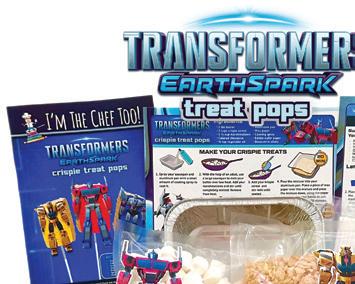
52 progressivegrocer.com SOLUTIONS Baking
Contact us: PSSales@UNFI.com E-Commerce, Your Way Whichever way your customers want to shop, we’ve got you covered.
I'm the Chef Too! offers family-friendly STEM-based baking kits online, including one enabling home chefs to create Transformers Treat Pops.
Have a taste. Nothing’s stopping you.











Introducing our new line of dairy-free chocolate. It’s everything you expect Guittard chocolate to be — obsessed over, exquisitely crafted, intensely delicious — but now free of all 14 major allergens and sensitivities.





Ice Cream & Frozen Treats
Cooler Than Ever
OFFERINGS PLAY UP HEALTHY ATTRIBUTES, CONVENIENCE AND INNOVATIVE FLAVORS WHILE STILL OFFERING HIGH QUALITY AND INDULGENCE.
By Bridget Goldschmidt
hey may be primarily thought of as warm-weather indulgences, but ice cream and frozen treats are popular year-round — in spite of evolving consumer diets, lingering supply chain woes and even inflation.
Raising the Bar
Aware of consumers’ unshakeable love for sweet frozen treats, Phoenix-based Sprouts Farmers Market teamed with Casper’s Ice Cream to showcase the latter company’s Jolly Llama Half-Dipped Yogurt Bars across the grocer’s nearly 400 stores in 23 states. The recently launched line comes in Strawberry ’N Cream, Cool Mint Chip, Coffee Espresso, Lemon Cheesecake and Chocolate Fudge flavors, all containing just 100 calories each.
“In early June, Sprouts began introducing exclusive products to consumers under its New for You labeling program,” notes Reed Damon, chief marketing officer of Richmond, Utah-based Casper’s. “We were thrilled to find out that Jolly Llama would be included in the August edition of this exclusive program. Sprouts shared that it is focused on putting unique products in front of its shoppers, and
McConnell's Fine Ice Creams, a maker of indulgent products made from the finest ingredients (left), has recently introduced at grocery a line of flash-frozen cookies (below), which the company has offered in its scoop shops for years.
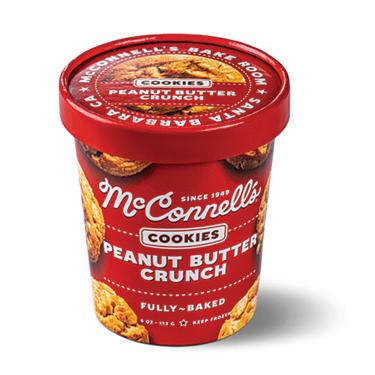
this partnership helps build our credibility. Additionally, to entice the trial, Sprouts is offering the yogurt bars to their consumers at a promoted price of $4.99 every day for the remainder of 2023.”
According to Damon, “Over the last few years, we’ve noticed a shift in consumers seeking out frozen options that can accommodate a range of dietary needs, as well as healthier options. ... With Jolly Llama, it is really about the intersection of better-for-you and indulgence.”
As for the varieties offered in the HalfDipped Yogurt Bars line, he observes: “Ice cream fans are constantly looking for new flavors. … Continuing to provide delicious and high-quality products while also ensuring these products continue to satisfy cravings with multiple textures and bold flavors will always be a trend we focus on.”
Accent on Indulgence
Despite better-for-you innovations in this space, the desire for old-school decadence persists — albeit with a difference.
“The McConnell’s customer wants an indulgence,” emphasizes Michael Palmer, owner and CEO of Santa Barbara, Calif.-based McConnell’s Fine Ice Creams, a dairy whose product lineup includes a new

Key Takeaways
Over the last few years, consumers have been seeking out frozen dessert options that can accommodate a range of dietary needs, as well as healthier options. Sustainability and personalization are also becoming increasingly important to frozen dessert consumers.
High-quality ingredients and satisfying taste and texture remain important in the category, accentuated by indulgent new flavors.
54 progressivegrocer.com FROZEN FOODS
PHOTO BY TANA GANDHI
line of scratch-made organic ice creams. “They trust that we’re going to deliver on the finest ingredients, with flavor profiles that range from classic to more foodie.” Palmer adds that novel seasonal flavors can help keep interest alive when the weather cools.
A key part of McConnell’s business is retail partnerships with such grocers as Encino, Calif.-based Gelson’s, which operates 27 upscale grocery stores in Southern California. “Over many years, they’ve been incredibly supportive,” affirms Palmer. “From a strategic standpoint, they offer valuable insight — relative to the category, certainly, but also in terms of what’s valuable to them and their customer base. … Their deep understanding of our customer has really helped us when it’s come to crafting our go-to-market strategy for some of these new products, whether launching products in new categories or, literally, making key merchandising decisions, from packaging to flavor profiles.”
Along with wellness and personalization, Palmer believes that going forward, sustainability will be an important trend in ice cream and frozen treats. “Packaging is a particular area of interest,” he says. “Consumers are becoming increasingly conscious of the environmental impact of their choices.”
Frozen Disruptors
Who says that frozen treats need to be only ice cream, yogurt or their plant-based equivalents?

McConnell’s, for one, has debuted a line of 100% made-from-scratch cookies at grocery. According to Palmer: “[T]he cookies are fully baked and flash-frozen, allowing them to be conveniently ready after heating for just a few minutes in the oven. This is something we wanted to do to address consumers’ desires for an elevated yet effortless indulgence we’ve offered in our scoop shops for years.”
Then there’s Sebring, Fla.-based CitraPac Inc., which aims to disrupt the frozen fruit category with Nature’s Premium Fruit Pearls, a cryogenically frozen all-natural snack featuring a combination of real fruit, or fruit and creamy yogurt. Read more about this product on page 24 of Progressive Grocer’s Editors’ Picks in this issue.
 This past August, the Jolly Llama Half Dipped Yogurt Bars line from Casper's Ice Cream was exclusively featured at Sprouts Farmers Market stores.
This past August, the Jolly Llama Half Dipped Yogurt Bars line from Casper's Ice Cream was exclusively featured at Sprouts Farmers Market stores.
Turning Points
THE ARRIVAL OF COLD WEATHER BRINGS RICHER NOTES AND THE RETURN OF HOLIDAY BEER AND WINE FAVORITES.
By Lynn Petrak
s growers wrap up their harvests of grapes and hops, the seasons are also changing for finished wine and beer products. Grocers shifting out displays of summery seltzers and refreshing ales are making room for different and new varieties from local, national and international suppliers.
Given the fact that the rollout of pumpkin spice offerings has become a harbinger of fall in other drink categories, it’s not surprising that similar-flavored adult beverages have started hitting store shelves and will continue through Halloween and Thanksgiving. In late summer, for example, The Fresh Market, based in Greensboro, N.C., revealed that its roster of fall-themed products would include pumpkin beer.
Many beer makers are bringing back pumpkin brews that are part of their usual rotation, and others are introducing new twists on this autumn favorite. New Belgium Brewing Co., based in Fort Collins, Colo., is mixing it up with Atomic Pumpkin, featuring classic cinnamon spice and pumpkin, along with a spicy habanero pepper flavor. Boston-based Samuel Adams is touting its Jack-O, made with a balance of cinnamon and nutmeg, with citrus tones for added brightness. Dogfish Head Craft Brewery, of Milton, Del., is getting a start on the season with Punkin Ale, made with real pumpkin meat and available this year for the first time in cans.
Beyond the pumpkin spice flavor profile, brewers are adding more layers in other ways during the cool season. As always in this category, evocative product names are designed to grab attention at the shelf, such as Flannel Friday from Boston’s Harpoon Brewery, featuring notes of caramel and roast, and Williamsport, Pa.-based New Trail Brewing Co.’s Flannel Weather New Zealand-style hazy double IPA. The Belgian-style brewer Allagash, located in Portland, Maine, is also going for imagery with its North Sky stout, which features a roasted chocolate flavor that plays off the Belgian yeast.
Another way to make a beer name stand out on shelf is to co-brand it. For example, in time for the fall tailgate season, the University of Southern California Athletics group is teaming up with SoCal brand Stone Brewing to produce a Stone Fight On! Pale Ale. The drink is available at stores, restaurants and bars in the region, in addition to the Los Angeles Coliseum and Galen Center, which are home venues for the USC Trojans teams.
“Stone beers are popular nationwide and across the globe, but SoCal is where we started and is home to our biggest population of fans,” says Erin Smith, VP of marketing at Escondido, Calif.-based Stone Brewing. “We’re thrilled at the opportunity to create a beer that instills local pride in that cross-section of craft beer drinkers and USC fans and alumni. It’s our hope that this beer is enjoyed year-
Key Takeaways
Beer- and winemakers are getting into the spirit of the season with fuller-bodied products, autumnal flavors such as pumpkin spice, and evocative product names. Cooler-weather and holiday beers and wines are creeping into assortments earlier than ever, starting in late summer.
Other ongoing trends in the adult beverage category include sustainability and low- and noalcohol offerings.

56 progressivegrocer.com BEVERAGES Fall Beer & Wine Review




CLA has a deep understanding of industry issues facing both the brick-and-mortar and e-commerce retail spaces. We’ll help you take care of the practicalities of creating, growing, and running a retail business, so you can bring your vision to life. Get started now at CLAconnect.com/nourish ©2023 CliftonLarsonAllen LLP. CLA (CliftonLarsonAllen LLP) is an independent network member of CLA Global. See CLAglobal.com/disclaimer. Investment advisory services are offered through CliftonLarsonAllen Wealth Advisors, LLC, an SEC-registered investment advisor. Building a brand takes balance.
Scan Here

BEVERAGES
Fall Beer & Wine Review
Allagash's North Sky stout is one of many fall beers that convey seasonality through name and design.
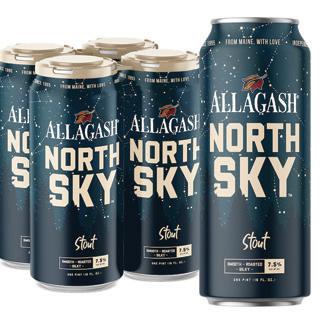
round for its incredible fl avor, and that it truly adds to the game-day experience across all USC sports.”
Likewise, the Keystone brand from the Molson Coors Brewing Co., in Golden, Colo., is gearing up for sweater weather with a co-branded fall campaign centered on a popular autumn pastime. To kick off hunting season, the brand is tucking bright-orange cans into seasonal packs of Keystone Light and partnering with Columbus, Ga.-based hunting lifestyle brand Realtree to offer hunters a chance to win merchandise like coolers, jackets, flannels and beanies.
Other craft brews are infused with different signature tastes of the season. Genesee Brewing Co., based in Rochester, N.Y., is promoting its Cran Orange Kellierbier, already available in many stores and complementing its traditional Oktoberfest variety.
Smoky fl avors are also fi nding their way into beers, bringing to mind bonfi res and the deeper fl avors that arrive with autumn. Juneau-based Alaskan Brewing Co. is introducing a Smoked Porter beer. Other beermakers are also going Old World in this way, offering German-style rauchbier made with smoked malts.
Winemakers are similarly getting into the spirit of the season. In addition to promoting fuller-bodied wines that pair well with heartier meals as the weather turns, retailers can merchandise wines that have a holiday link. For instance, in addition to its pumpkin beer, The Fresh Market is highlighting a Spellbound Pinot Noir and Ghost Pines Red Blend with a Halloween aesthetic. On the supplier side, Omena, Mich.-based Leelanau Cellars is bringing back its Witches Brew Spiced Red Wine as the leaves in its vineyards turn color.

Rollouts Roll Back
The early push to swap out seasons is arriving earlier than ever, with some CPGs and grocers moving to fall flavors and merchandise in early August and narrowing those displays in late September and October to make way for holiday items.
According to Tiffany Benning, brand manager at Genesee Brewing Co., the company is tinkering with a summertime start. “There has been an ongoing debate for years about when we should release our fall beers,” she notes, “so we decided that it’s time to let the fans have the floor. We want to hear if people are ready or not.” This year, Genesee is asking consumers to message the company directly on social media platforms to share their opinions.
Just as pumpkin, apple and Halloween-inspired beers and wines are creeping into assortments earlier, so are holiday offerings. Look for brands like BuzzBallz, based in Carollton, Tex., to get the festivities going as soon as possible; last year, BuzzBallz’s wine-based Chillers included an eggnog variety featuring a rich vanilla flavor and hints of cinnamon and nutmeg over an orange wine base.


© 2023 Southern Champion, Carrollton, TX. All Right Reserved. “Enjoy Responsibly.” © 2023 Southern Carrollton UptownCocktails.com
The Keystone light brand is taking a different approach to fall themes with a hunting pack and promotion.

Also Trending This Season


In addition to seasonal varieties cropping up, there are some other beer and wine trends of note as the year comes to a close.
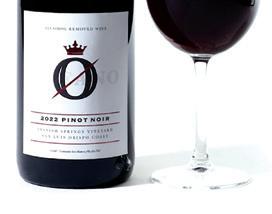
The push for sustainability continues as beverage brands and grocers work to hit their environmental targets. According to data from Chicago-based NielsenIQ (NIQ) alcohol products with attributes such as “eco-friendly certifi ed” and “responsibly sourced” grew at a faster rate than other products within the total beverage alcohol sector last year.

Imperfect Foods, for its part, is joining Delanco, N.J.-based parent company Misfits Markets in offering shoppers wines that align with the e-grocers’ sustainability values through a variety of organic and sustainable options. The companies began a Rescued Wine program, selling wines with labels that have been lightly marked or scuffed and are no longer bound for store shelves.
Among mainstream grocers, Safeway and its parent, Albertsons Cos., have recently added a curated collection of wines called Vine & Cellar that can be directly shipped to consumers’ homes.
“We are launching Vine & Cellar to give our customers and fellow wine enthusiasts the ability to discover and shop regional and specialty wines from smaller vineyards that are not usually available at national supermarket retailers,” explains Curtis Mann, Master of Wine and group VP of alcohol for Boise, Idaho-based Albertsons.
Meanwhile, even as people get together for occasions like tailgating and holiday parties, some of them are looking for lower-alcohol options. According to a survey commissioned by New York-based NCSolutions, 34% of U.S. consumers report that they’re trying to drink less alcohol in 2023. The survey also showed that 36% of consumers have tried nonalcoholic beer and 12% have sampled alcohol-free wine. NIQ reports that dollar sales of nonalcoholic drinks rose 20.6% between 2021 and 2022, and that 82% of nonalcoholic beer, wine and spirit buyers are also purchasing products that contain alcohol.
One new entry in the field comes from Oceano Wines, a Paso Robles, Calif., winemaker that recently added its first ultra-premium nonalcoholic wine. Additionally, earlier this year, the venerable Dutch brewing company Heineken, whose U.S. headquarters is in White Plains, N.Y., introduced Heineken Silver, a lower-carb, lower-calorie 4% ABV product.
As low-ABV products and the "sober curious" movement gain traction, Oceano Wines has come out with a premium nonalcoholic wine variety.
 © 2022 BuzzBallz, LLC, Carrollton, TX Please Drink Responsibly
© 2022 BuzzBallz, LLC, Carrollton, TX Please Drink Responsibly
PR
© 2023 BuzzBallz, LLC, Carrollton, TX Please Drink Responsibly
Food Safety is Good for Business
AN EXPERT OFFERS THREE STEPS FOR GROCERS TO REALIGN THEIR FOOD SAFETY PROGRAMS.
By Chris Boyles
y all signs, the grocery business is looking up. In the first half of 2023, major supermarket chains reported steady performance, increased revenues and heightened e-commerce sales. However, many grocers are also facing challenges that can put food safety — and their reputations — at risk. To help minimize that risk, now is a great time to re-evaluate your food safety initiatives to be sure they align with your current operations.
The Ripple Effect of a Labor Shortage on Food Safety
Finding and keeping store-level help remain issues for many locations. This prolonged labor shortage can affect food safety. As managers work to keep operations running smoothly, food safety training for new team members can be cut short or not take place at all. Even tenured staff members might be tempted to take shortcuts as they juggle a busier workload than usual.
This can mean that tasks that are time-consuming or that don’t appear to have an immediate impact on food safety can get skipped. For example, keeping a temperature log requires training time and a commitment to logging temperatures throughout the day. When temperatures aren’t logged repeatedly, it can lead to critical food safety infractions or important equipment maintenance not being addressed.
Increases in New Practices, But No Updated Policies
Another challenge that many stores are facing is the swift uptick in curbside pickup and delivery orders. As these channels have continued to increase post-pandemic, many stores have adopted procedures to accommodate these consumer behaviors. Yet some retailers haven’t implemented formalized food safety practices, leaving significant gaps that can put consumer health at risk.
Third-party delivery presents other challenges. Once products are picked up, the store has little control over the time it takes to deliver, safe handling and potential contamination. When problems occur, however, buyers tend to point the finger at the organization they ordered from. In a survey of 3,000 North American adults conducted in the fall of 2022, when Steritech asked consumers who they felt was ultimately responsible if an online order didn’t meet their expectations (inaccurate, delivered at the wrong temperature, etc.), 55% blamed the store or outlet they ordered from, while only 28% blamed the third-party delivery service.
Three Steps to Realign Your Food Safety Program
Given these challenges, retailers must take extra steps to ensure that food safety remains top of mind for every worker across their ecosystems. Now is an opportune time to re-evaluate your organization’s food safety policies and practices. To make that process more manageable, center your efforts on these three key areas:
1Craft an organization-wide food safety commitment statement
Food safety begins at the top in any organization. To give employees across your enterprise a guidepost and a universal rallying point, implement a written food safety commitment statement. This statement can be part of your mission statement or stand alone, but it should be short and memorable.
An example of a strong food safety statement might sound something like this: “We are committed to providing our customers with safe, high-quality products in clean, well-organized stores, staffed by highly trained, friendly associates who prioritize customer service and convenience.”
The statement should be put into practice, help guide leaders’ business decisions, be discussed regularly and be modeled by leaders at every level of the organization. It should be written and highly visible on a variety of channels so it remains top of mind for employees every day.
Another great way to live out your statement is in customer-facing communications. For example, one major grocery retailer prints safe cooking temperatures on its plastic bags in the meat department. If your store offers meal kits, print food safety reminders on the recipe card. For prepared food areas, simple stickers that remind your customers of food safety practices, such as “Refrigerate after use,” can reinforce your brand’s commitment to shoppers’ safety.
2Implement or review your food safety management system
A food safety management system (FSMS) is defined as a structured process implemented by a food establishment to ensure that its practices reduce the risk of foodborne illness and produce the safest foods possible. Every food retailer should have a documented FSMS in place and ensure that it’s understood by managers and front-line workers who are tasked with high-risk work. Doing so can have a dramatic impact on performance.
Based on a study done on supermarket delis by the U.S. Food and Drug Administration, delis where the person in charge at the time of the inspection could discuss the organization’s well-developed food safety management systems had nearly half the number of cited issues.
60 progressivegrocer.com GUEST VIEWPOINT
Food Safety
If your store doesn’t already have an FSMS in place, begin with identifying food safety risks by department or area. Include the following three elements:
Procedures that document critical limits or steps, as well as the proper processes to control the risk.
Training for everyone who engages in that behavior, including clearly established guidelines of who conducts the training.
Monitoring of the procedure to ensure the proper process is being followed.
Examples of high-risk practices can be found in the FDA’s 2021 study on food retail delis. The agency focused on 10 key practices that included proper handwashing, protecting food from cross-contamination, properly cleaning and sanitizing food contact surfaces, cold and hot holding, and proper cooking temperatures.
If your store has an FSMS in place, you’re already in a great position. However, consider testing your managers’ knowledge of the FSMS. If they don’t know it, implement training initiatives to ensure that they have a good working knowledge of it.
3Employ a continuous-improvement process
To ensure that food safety remains protected, retailers should commit to using a continuous-improvement process in their food safety plan. This involves holding the organization (and its people) accountable for food safety goals.
The first step in a continuous-improvement process is identifying where improvements are needed and establishing key performance indicators (KPIs) to measure success. This should be a focused list of a few key areas where improvements will make a substantial difference to food safety and, ultimately, your customers and brand. Here are two examples of a well-constructed KPI.
Organizational





New-hire training completion rate: Improve average number of days for employee food safety certification from 20 days to 15 days.
Department-specific
Citations on quarterly third-party inspections: Reduce average critical issues in bakery from 1.9 to 1.5 within the next six months.
Mobilize your teams around your KPIs. Be sure that everyone in the organization knows them. Whether they play an active role in achieving the KPI, everyone has a part to play in supporting their teammates in reaching goals.
Adopt a “Plan, Do, Check, Act” approach to ensure that your KPIs and other critical food safety processes aren’t just static targets, but that the organization is holding itself accountable and continually taking steps to make incremental improvements.
While every organization is different, there are many ways to practically implement a continuous-improvement process for food safety. Consider these steps as part of your planning: Include food safety responsibilities or KPIs in job descriptions
and discuss them in performance reviews. This ensures that individuals understand the importance of food safety and see it as part of their job responsibilities.
Leverage an independent third-party organization to conduct regular food safety evaluations. Having an objective, outside review of your food safety practices can help provide a clear picture of where your organization needs to focus its efforts.
Empower your teams through a formalized self-evaluation process. Having your teams conduct evaluations of their own performance can help them identify areas of concern and work to improve them before they become issues. However, conducting self-evaluations requires special skills. Those performing them should be trained in how to inspect, how to document what they’re seeing and how to investigate for root cause.
Perception is Everything
Consumer awareness of public-health and -safety issues is at an all-time high. While many food safety practices may go unobserved, there are just as many that can be visible to your customers. Produce that isn’t rotated regularly can attract fruit flies, malfunctioning coolers can develop condensation or frost, and employees who are sick while working are examples of issues that can make customers question your brand’s commitment to food safety and to their health.
On the other hand, customers who observe your employees culling produce, notice the sparkling-clean display cases or pick up a meal kit with clear food safety instructions will know that your store is committed to their health and satisfaction. That can give a boost to customer trust and loyalty and drive sales. Implementing documented, detailed food safety plans isn’t just the right thing to do, it’s also good for your business.
As VP of food safety, Chris Boyles manages the consulting and regulatory affairs functions for Charlotte, N.C.-based Steritech. This includes leading consulting services such as program gap analysis, crisis management and research projects. He also oversees Steritech’s OneLook service, which consolidates and standardizes regulatory inspection data. Prior to Steritech, he was responsible for quality assurance of private label products at Harris Teeter Supermarkets.


PROGRESSIVE GROCER September 2023 61
Customers who observe your employees culling produce, notice the sparkling-clean display cases or pick up a meal kit with clear food safety instructions will know that your store is committed to their health and satisfaction.
KAIVAC® CLEANING SYSTEMS FOR GROCERY STORES




RESTROOMS
SPECIALTY AREAS
SCAN
MORE INFORMATION
FOR




FLOORS CUSTOM SOLUTIONS REFRIGERATION Call Kaivac at 800-287-1136 or visit us at kaivac.com to learn more. Grocery store cleaning presents unique challenges. Keeping a clean, safe and inviting store is incredibly demanding, but absolutely necessary. From customer impressions to food safety, cleanliness in the grocery business is a key component in customer loyalty, reputation and profitability. At Kaivac, we create and test science-based, worker-friendly solutions that measurably deliver maximum results with minimum effort while remaining cost-effective all while protecting the worker. Clean is Good for Business.
Leading Edge
NEW TECHNOLOGIES IN THIS AREA ENABLE GROCERS TO BETTER CONNECT WITH CUSTOMERS IN AN INCREASINGLY OMNICHANNEL WORLD.
By Mike Duff
helf-edge and related technologies are rapidly evolving, becoming less costly and more capable while providing options that allow grocers and other retailers choices in how they want to invest for the maximum benefit.
Samsung, for one, is working with retailers to get them onboard with in-store digital technologies, applying its knowledge of video, networks and software to support applications that can satisfy multiple goals, from reducing labor to supporting promotions. It no longer makes electronic shelf labels (ESLs), but it works with companies that produce them and uses its own expertise to give grocers access to what shelf-edge technology can do for them, whether they want to initiate a program, upgrade an existing one, or explore new opportunities such as in-store advertising, a capability that Samsung supports.
Parrish Chapman, senior director, enterprise retail sales, key accounts at Samsung Electronics America, in Ridgefield Park, N.J., describes the opportunity that grocers have when it comes to shelf-edge technology as “massive,” given the store traffic that such initiatives can reach.
The potential of in-store digital selling is becoming increasingly evident, and grocers that have become more involved in omnichannel operations have recognized the advantages available if they can interact with customers in stores as they do online. However, many grocers have yet to begin, or are only somewhat involved in, up-to-date shelf-edge technology.
According to Chapman, Samsung is not only helping grocers that are already sophisticated in their use of in-store technology, but also those who are taking their first steps. One way the company does so is by helping them look at a store in a compartmentalized fashion, building on the different ways that consumers shop and that retailers present goods across different departments.
Focusing Investments
Although ESLs that can be automatically updated get a lot of attention, many grocers that are interested in shelf-edge tech investments shy away from a commitment to — and the cost of — ESLs early on. Chapman says that these grocers generally favor smaller investments in screens that focus more on product information and messaging, and then look at return on investment. Samsung works with customers to focus investments where there are better opportu -
Key Takeaways
Shelf edge isn’t just about optimizing price and promotion, although that can and should be a key consideration in a storebased digital effort.
In-store digital technology can include branding content and feel-good messaging meant as much for employees as for customers, and which can even help with retention.
Shelf-edge tech can also couple with inventory management using AI-powered algorithms to predict product demand and inventory levels more accurately, and support in-store navigation systems that guide customers to specific products.

64 progressivegrocer.com TECHNOLOGY Shelf-Edge
Solutions
The shelf edge is where shoppers arrive at final purchasing decisions, and technology that provides relevant product information or makes a clear value pitch can become the final factor that converts a browser into a buyer.















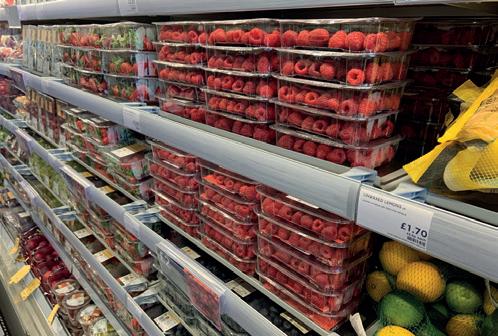



oils v . w oil ow is , , oil ov w? oils ov ow ov , is oil. w oils w U , oils w 25%, oils -c s -w s 80% v oil – s W w ollo v s. 2 o US W w, v 38 - v is is ” will l S oils , s v is oil oil is is, oil. s is -c , is s il . oils v s w oils - C , cl oil W o s U cov s, so l oil l w v U S O oils www www (57 8 is oil oil - U s ? s l ov , c so is col is cos oils il w col , l, s , o v oil? 1 , oils . So w Wil (W oil ol -c


Shelf-Edge Solutions
nities to drive business, bringing its expertise with content to bear in that effort.




“You can divide the store up into shops-within-a-shop, and let’s say we talk about the candy aisle,” he notes. “We can create a whole digital experience for the candy aisle that is amazing. We know, with this technology, if the traffic goes up or down, if dwell time is increasing, and if you stay longer, you buy more.”
Shelf edge isn’t just about optimizing price and promotion, although that can and should be a key consideration in a storebased digital effort. A narrow focus on price will become less effective over time if unsupported by feature displays that handle other kinds of messaging. ESLs that are more capable than those narrowly displaying price, including those with squared configurations or that add bibs containing additional information, can provide support. The opportunity is to offer content and even shopping support to consumers in-store that encourages interaction and, as a consequence, more purchasing. Samsung is working with and even developing software to give grocers advantages that are consistent with their operations. For example, it’s sourcing sophisticated weather data and applying it in the food retailing case.
“We’re doing forecasting; we’re doing weather triggers and alerts on weather,” affirms Chapman. “Weather is becoming this issue in America, and we want to use it to build branding. So [in] all our launches now, we’re including weather as an intellectual product to capture people’s attention.”
He adds: “Most CEOs say we need to get 15% sales growth. What we tell our clients is: ‘Where are we going to focus that in stores? Where do you want it to come from?’ That’s where this content is so important. You have to have a balanced content approach. We’re talking about the proper location, and you provide something that’s fun and informative and interactive.”
Getting Started
Shelf-edge technology programs can start with the use of dedicated tags that convey information relevant to where they’re placed, whether as an element on an ESL or even a paper tag, or a tablet screen on an end cap. In one example, a store could put in several small shelf-mounted screens that focus attention on a range of content, including product information, deals, loyalty program features, and even social media, which, if properly deployed, can keep the conversation started in-store going when the consumer is outside the store.
By starting with more informational displays, including larger screens on end caps and split screens meant to include informational and pricing presentations for a particular section, grocers can see the value and get a sense of what the investment return is on shelf-edge and associated technology. It’s then that consideration of ESLs can become more attractive. Beyond marketing and pricing, in-store digital technology can include branding content and feel-good messaging meant as much for employees as for customers, and which can even help with retention. Thereafter, monetization becomes part of the discussion. According to Chapman, going in with monetization as the first priority isn’t the best way to get involved with shelf-edge technology if a grocer is going to get the
maximum benefit. Samsung can help with the network it developed, however.
A Diff erent Perspective
Based in Preston, Victoria, in Australia, In2Digital is a strategy and advisory firm that works on shelf-edge technology, including Samsung display systems.

Founder and CEO Francesca Surace says that supermarkets and other retailers in the markets in which In2Digital engages are placing more emphasis on productivity, and that becomes an inducement to working with internet-linked ESLs and other digital signage that require little human interaction.
Supermarkets and other retailers “are placing a greater emphasis on productivity benefits, which involves reducing the number of floor staff required to perform traditional, labor-intensive labeling updates,” she notes. “Some retailers are investigating the potential wider business benefits that come with full backend integration, such as linking in-store digital signage and an event-driven IoT [Internet of Things] ecosystem.”
According to Surace, digital signage offers different retailers opportunities in tune with their operations.
“High-end fashion stores may use larger ESLs and digital shelf-edge displays that showcase more marketing information, while fresh food stores may use larger ESLs to display nutrition information,” she says. “The ESL market offers a variety of label options to cater to diverse use cases, from simple grocery stores to mobile phone shops that use NFC tap for more product information or back-end stock displays. These technologies are flexible and valuable tools for businesses.”
Although some retailers look at shelf-edge technology in a limited way right now, especially for productivity gains, grocers and other store runners can take a broader view across a much wider range of opportunities when devices such as ESLs are combined with other advancing tech.
“With integration in back-end software and IOT, coupled with the emerging capability of AI, we can expect to see significant advances in the use case of these technologies and solutions,” predicts Surace. “Key areas include dynamic pricing using AI to automatically gather competitive pricing and recommend price changes, and personalized promotion that can be displayed on ESLs, providing customers with personalized deals and recommendations as they walk through the store.”
68 progressivegrocer.com TECHNOLOGY
“When you talk about pricing optimization, you become more efficient [and] you become more effective promotionally.”
—Matt Pavich, Revionics
THE STORE BRANDS PHENOMENON

Presented by the Private Label Manufacturers Association For U.S. retailers, store brands have become a powerful strategy that provides points of differentiation and builds consumer loyalty. They are also shoppers’ best friend, offering the highest levels of innovation, performance and quality. As store brands move into new categories, chains, and channels – winning new fans every day – one word describes them best: Phenomenon. Experience them for yourself in Chicago. Register at www.plma.com or call PLMA at +1 212 972-3131 or email info@plma.com.
PLMA’s 2023 PRIVATE LABEL TRADE SHOW NOV. 12-14 • CHICAGO
Shelf-Edge Solutions


Shelf-edge technology can also couple with inventory management using AI-powered algorithms to predict product demand and inventory levels more accurately, thereby reducing instances of out-of-stocks and overstocks. In terms of data, retailers can use AI to analyze customer demographics and shopping behaviors, and display location-specifi c advertisements on ESLs. In doing so, they can help promote products that are relevant to local customers. Shelf-edge technology can also support in-store navigation systems that guide customers to specifi c products using interactive maps displayed on ESLs.
Consistent Results

Matt Pavich, senior director of strategy and innovation at Alpharetta, Ga.-based Revionics, a pricing optimization solutions provider for retailers, notes that ESLs today have a solid business case behind them as technology and the market have evolved in areas such as price optimization. Even the hardware itself has become more formidable, with longer battery life that can keep an individual ESL working for eight years and sometimes 10.
However, pricing optimization and promotion, combined with shelf-edge technology, can provide substantial returns. According to Pavich, well-managed price optimization and promotion have allowed Revionics customers to outperform the market, gain share and even grab customers from rivals. Pricing optimization strategies using AI to gather relevant data provide grocers and other retailers a better understanding of what prices and discounts have the maximum effect in different locations. They can even save retailers money by demonstrating how deep a discount is enough to generate the sales wanted. Because the use of tools such as price optimization is based on exacting science, grocers can get consistent results and even venture into predictive analysis to deal with situations on the horizon.
“When you talk about pricing optimization, you become more efficient [and] you become more effective promotionally,” says Pavich.

He makes the point that price optimization backed by AI has been around for quite a while, powering the constant price changes that are commonplace in e-commerce. Given the familiarity that today’s grocers have with omnichannel strategy, more executives than ever are eager to apply these types of solutions in stores, as they already do digitally. As its integration in physical stores becomes more sophisticated, personalization becomes part of the equation. Stores won’t be changing prices for individual customers, but a loyalty app can direct them to the promotions that are most relevant to them.
The combination of shelf-edge technology and price optimization can have a dramatic effect in-store. Labor savings on price changes is an immediate result, given that retailers can now change an ESL automatically. Not only does it enable an employee to go from working on shelves to working with customers, it also eliminates concern about how many price changes can be made in a day, given the available labor.
Paper Trail
Still, if ESLs get a lot of attention, many grocers have tapped solutions that don’t require investment in individual ESLs but deliver many of their benefits if consistently applied.
Ryan Yost, VP general manager at Avery Dennison, in Mentor, Ohio, estimates that 95% of the work that he does in shelf-edge technology, including with the company’s Vestcom business, involves paper, with just 5% involving ESL. He contends that grocers don’t need to rely on any single shelf-edge technology. In situations with highly promotional goods or those otherwise subject to frequent price changes, ESL may be ideal. Still, for products that typically have only a few regular price changes over the course of a year, the investment might not be worth it.
Paper tags such as the ones Avery Dennison offers, which don’t just offer price, but also have space for messaging, may make more sense for product categories where pricing is consistent. What’s more, the labels are easy to mount and come in a stack that’s subject to an automated process in printing, so that each is sequenced. An employee with a stack of tags can start at the beginning of the first aisle and proceed along the shelf directly, as the tags correspond to the order of products as merchandised. The result is significant labor savings as opposed to the old way of doing things that had employees hunting around the store to find the right place to mount a tag.
The labels also include space for promotional messages and other means of reaching out to the shopper. Messaging can let the consumer know that an item is new, what other products might be purchased in combination with it to assemble meals, and how the company behind the item is addressing social issues, and it can also link to social media accounts and posts.
Yost suggests that three elements should be in place to maximize the potential of shelf-edge technology: labor efficiency, sales uplift, and customer engagement as a means of building loyalty. Today, more capable ESLs, advanced paper tags, and video displays on end caps and even on coldcase doors can be combined as appropriate to provide grocers with positive results on the cost and sales side. Some emerging benefits that shelf-edge technology can provide include the ability to locate where a consumer is on the floor, what their preferences tend to be and what promotions they might consider. Privacy considerations have to be addressed, but when marketers have the ability to offer the consistent purchaser of granola who hasn’t bought any in a while a coupon while that shopper is passing the cereal display, more of the potential of shelf-edge technology will be achieved.
70 progressivegrocer.com TECHNOLOGY
Ryan Yost, VP general manager at Avery Dennison, suggests that three elements should be in place to maximize the potential of shelf-edge technology: labor efficiency, sales uplift, and customer engagement as a means of building loyalty.
Center Stage
CURRENT DISPLAY SOLUTIONS CAN HELP INCREASE SALES FOR GROCERS BY HIGHLIGHTING PRODUCTS IN A UNIQUE WAY.
By Emily Crowe
hile grocery display solutions are some of the most overlooked aspects of brick-andmortar stores by customers, it’s no secret that they can play a pivotal role in lifting sales. Today’s displays are all about putting certain items front and center, but how can retailers find the right mix of product, location and hardware to maximize sales?
Mix It Up
Perhaps the most important consideration when looking at display solutions isn’t the hardware itself, but what should go on top of it and how it can flexibly meet that need. From popular store-brand items and seasonal snacks to the

latest and greatest in bakery and meats, displays should be able to easily and effectively showcase products that can help drive the bottom line.
Bridgeton, Mo.-based Hussmann offers myriad display case options, and those made for specialty items like artisan bread and aged beef can help
Key Takeaways
Displays should be able to easily and effectively showcase products that can help drive the bottom line.
Location is another extremely important consideration when looking at display solutions. Attractiveness, as well as a level of interactivity, in display solutions can also help lead to increased sales.
PROGRESSIVE GROCER September 2023 71 EQUIPMENT & DESIGN Displays
Display solutions might be overlooked by the everyday shopper, but having the right hardware can help grocers increase sales.
spotlight products that can make a big impact on sales. The company’s Aged Beef Service Merchandiser has a stainless steel interior and can prominently display several cuts of meat, while its Artisan Bread Wall Case features five adjustable lighted levels for optimal product placement.
Stone crab is another specialty item that grocers can put front and center in a novel way, thanks to custom mobile displays from Garland, Texas-based Atlantic Food Bars. The Iced Stone Crab Merchandiser helps enhance the in-store experience while also offering an add-on mobile clam bar that can hold everything from grab-and-go accessories to iced fresh seafood, crab meat, cold packaged foods, and more.
ALCO Designs, meanwhile, has several types of produce tables that can help grocers refresh their displays and pack even more of a fresh product punch. The Gardena, Calif.-based company’s displays offer what it calls “the ultimate in sensory and visual fulfillment” through modular designs that can easily be updated, as well as built-in shelves that create storage for additional products and provide a great opportunity for cross-merchandising.
X Marks the Spot
In addition to product mix, location is another extremely important consideration when looking at display solutions. Hardware such as island displays and point-of-purchase shelving should be located strategically throughout the store to help encourage cross-merchandising opportunities as well as impulse buys.
According to Racine, Wis.-based Great Northern Instore, “When it comes to promoting products in-store, shoppers can be motivated to buy with a variety of tactics. Great Northern Instore applies proven insights to design activations with the
right colors, images [and] structure for an in-store location, so you can tantalize the taste buds of any shopper. Whether your product is a simple everyday snack or part of a gourmet dining experience, customers are likely to make impulse purchases based on artful food retail display signs.”
Great Northern makes custom food merchandising displays that help give certain products prominence in any aisle, end cap or front-of-store area. The company developed a merchandising vehicle to give Pringles additional placement at Grand Rapids, Mich.-based Meijer, for example, by placing gravity-feed solutions on top of coolers at checkout to help drive additional impulse purchases.

Get the Look
Attractiveness, as well as a level of interactivity, in display solutions can also help lead to increased sales. Hussmann’s Isla, for example, is a unique “design-your-own island” merchandiser that offers retailers a flexible way to display refrigerated, hot and dry items all in the same unit. A variety of product types can be aligned and placed with precision inside the unit, giving customers a lot to look at in a sleek and streamlined package.
When it comes to interactivity, companies like Durham, N.C.-based The Looma Project are offering tech-forward, immersive product experiences on existing shelves or at new displays. The Looma Project’s Loop product consists of a network of smart tablets installed in grocery stores to connect shoppers to the people who made the products, via authentic storytelling or education. Loop says that its offering is two to three times more productive than traditional end caps, and also promises 92% growth of trial rate for featured brands.
72 progressivegrocer.com EQUIPMENT & DESIGN
Displays
Great Northern Instore developed a gravity-feed merchandising solution to give Pringles additional placement at Meijer stores.
“Whether your product is a simple everyday snack or part of a gourmet dining experience, customers are likely to make impulse purchases based on artful food retail display signs.”
—Great Northern Instore
Refresh Your Salad Displays
Maximize merchandising space with NEXT™ 2.0 salad trays
Increase sales with a fuller, more attractive display

NEXT™ 2.0 salad trays allows retailers to increase merchandising space and improve product visibility. Each item remains faced and visible to the customer for easy product selection.
By incorporating NEXT™ 2.0 salad trays into a planogram, retailers can expand the selection of products displayed in the cooler aisle and showcase the freshness and variety of salads by keeping the product facing forward. This simplifies customer decision-making by providing easy access to each product.
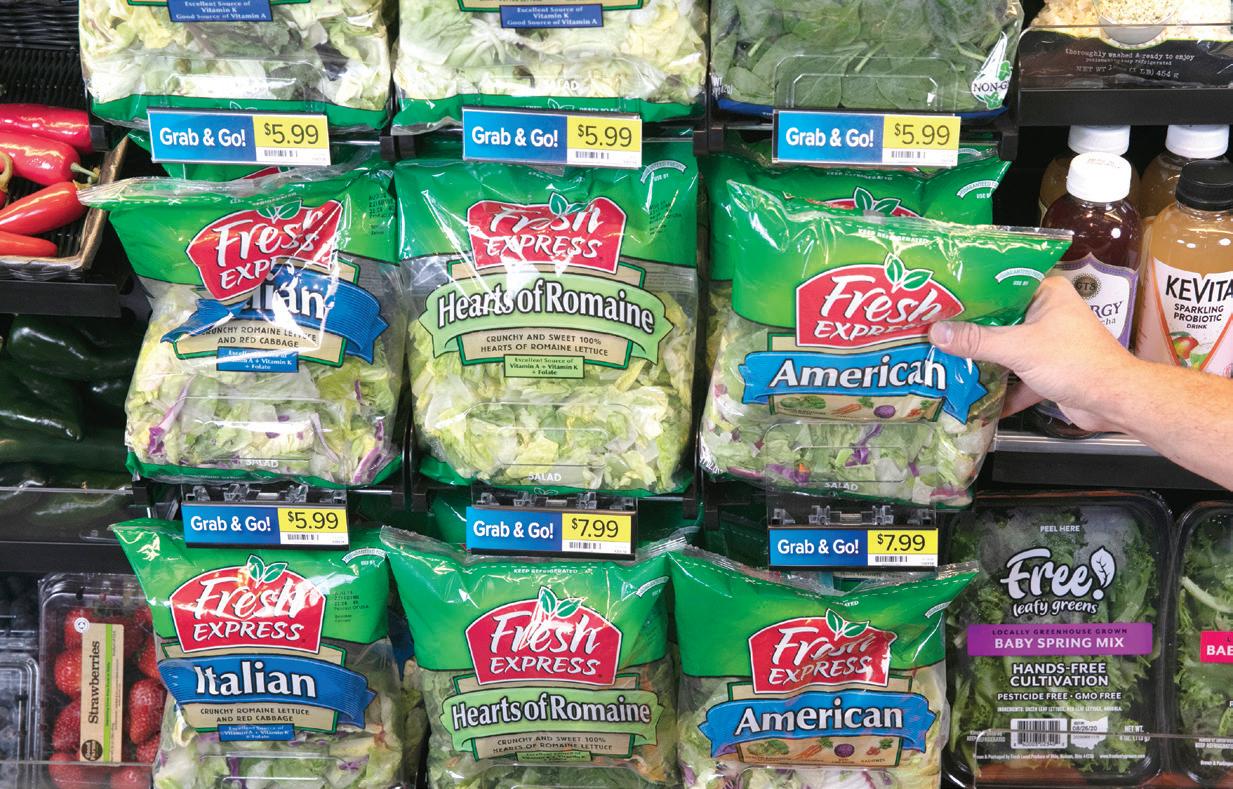
Retailers can further reduce labor costs and simplify restocking with the NEXT™ 2.0 pull-out tray option. Customers benefit from a more organized and cohesive layout featuring enhanced product depth and merchandising which, in turn, increases sales.
NEXT™ 2.0 trays are available with integrated baffles, to maintain proper airflow through the cooler
 NEXT™ 2.0 Trays
By Bridget Goldschmidt
NEXT™ 2.0 Trays
By Bridget Goldschmidt
A Dream Come True
A CHICAGO NONPROFIT EMPLOYS SMART LOCKERS TO ALLEVIATE FOOD INSECURITY.
new Save A Lot store on Chicago’s South Side has become the site of an innovative solution to food insecurity: To mark its third anniversary, nonprofit organization Dion’s Chicago Dream has launched The Dream Vault, a locker-based system to dispense fresh produce to those in need.

The network-enabled bank of lockers is designed to provide 200 households living within a 1-mile radius of the store with fresh fruits and vegetables, at no cost to them. Every week, a recipient can enter a code and pick up a box of produce.
‘Natural Progression’


“There’s never been a tool to fi ght food insecurity with quality options in a retail environment, so this is transformative in the nonprofi t space, and we hope it will provide a model for other organizations to scale up the services they are able to provide.”
—Dion Dawson, Dion’s Chicago Dream
Asked how the solution came about, Dion Dawson, founder and “chief dreamer” of Dion’s Chicago Dream, explains: “The Dream Vault was inspired by the smart locker system and is a natural progression of what we’ve already been doing — providing fresh, quality produce to food-insecure households in the Chicagoland area. I wanted to scale up by providing an option that not only would help residents, but would attract people to a local business, thereby incentivizing the business’ participation in fighting food insecurity. We worked with Luxer One to build the locker and with Save A Lot on the location. There’s never been a tool to fight food insecurity with quality options in a retail environment, so this is transformative in the nonprofit space, and we hope it will provide a model for other organizations to scale up the services they are able to provide.”
As for the choice of grocery store, “Save A Lot was my original target because I wanted this first Dream Vault to be located in Englewood,” notes Dawson, referencing his home neighborhood. “I went to them with the idea, and they jumped on it.”

More to Come
Since the program’s debut this past August, it’s been a win-win for all involved. “Save A Lot is very pleased with The Dream Vault,” says Dawson. “It’s low maintenance and brings in new shoppers. The recipients are very happy with the ease of use and are impressed with the ingenuity of the design.”
The plan is to launch at least four more Dream Vaults throughout Chicago with other partners by the end of the year. “We’re looking at the next launch to begin around Thanksgiving,” affirms Dawson, adding: “We intend to expand to larger

retail chains so that this tool is available across the city, and eventually in every corner of the country. Access to fresh, quality food is a human right, and for us, fighting food insecurity doesn’t stop in Chicago. This is a nationwide crisis, a worldwide crisis. We want to provide as many people as possible with access to healthy food when they need it.”
That may seem an ambitious goal, but over the past three years of its existence, Dion’s Chicago Dream has already provided more than 600,000 pounds of fresh fruits and vegetables to households in need throughout the Chicagoland area through its Dream Fridge and Dream Deliveries programs. For now, however, at least one of the nonprofit’s dreams has become a reality as it pioneers the use of frictionless grocery technology to aid some of the most vulnerable people in our society.
Bridget Goldschmidt Managing Editor bgoldschmidt@ensemleiq.com

AHEAD OF WHAT’S NEXT
74 progressivegrocer.com
Dion’s Chicago Dream founder and “Chief Dreamer” Dion Dawson (top) was proudly on hand when The Dream Vault, a locker-based system pioneered by his nonprofit, went live at a South Side Save A Lot.






































































































































































































































































































































































































































































































 Kroger's collaborations with Kitchen United and other ghost kitchens enable shoppers to order fresh food from multiple national, regional and local restaurant brands at the same location.
Kroger's collaborations with Kitchen United and other ghost kitchens enable shoppers to order fresh food from multiple national, regional and local restaurant brands at the same location.






















































 This past August, the Jolly Llama Half Dipped Yogurt Bars line from Casper's Ice Cream was exclusively featured at Sprouts Farmers Market stores.
This past August, the Jolly Llama Half Dipped Yogurt Bars line from Casper's Ice Cream was exclusively featured at Sprouts Farmers Market stores.















 © 2022 BuzzBallz, LLC, Carrollton, TX Please Drink Responsibly
© 2022 BuzzBallz, LLC, Carrollton, TX Please Drink Responsibly






































 NEXT™ 2.0 Trays
By Bridget Goldschmidt
NEXT™ 2.0 Trays
By Bridget Goldschmidt







